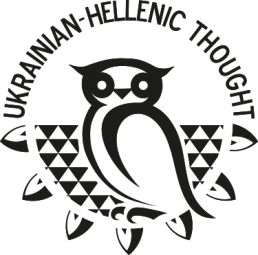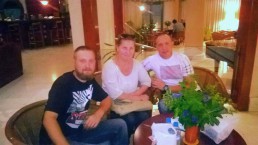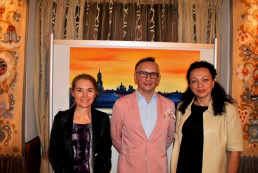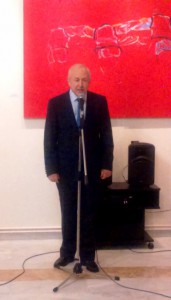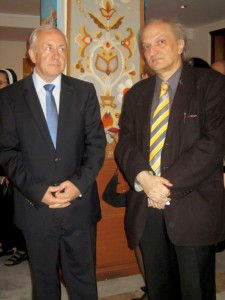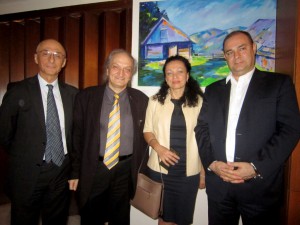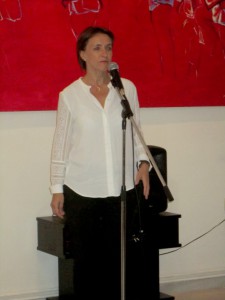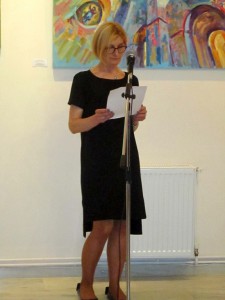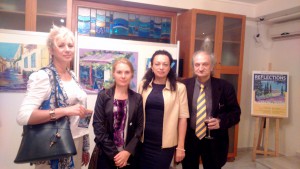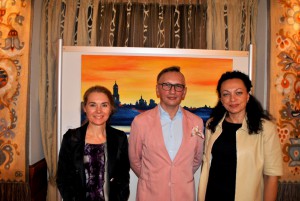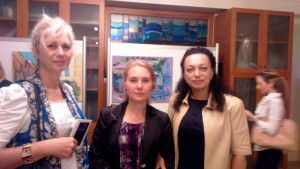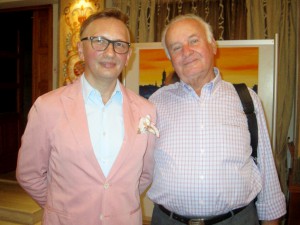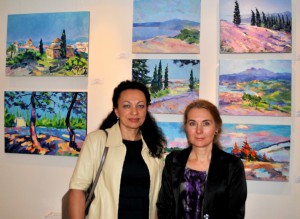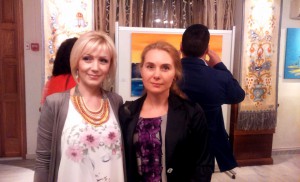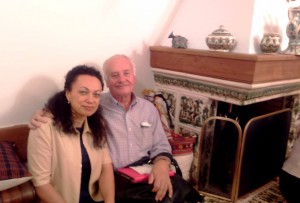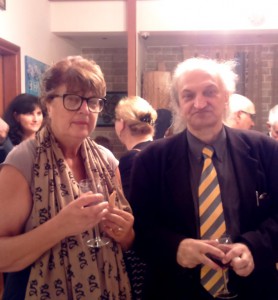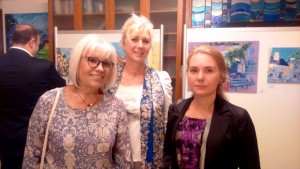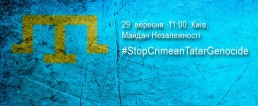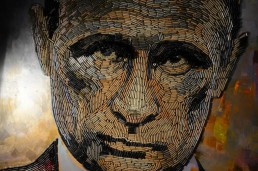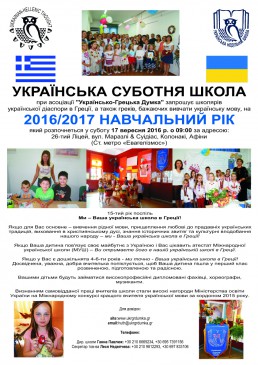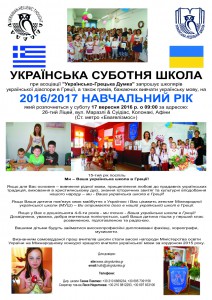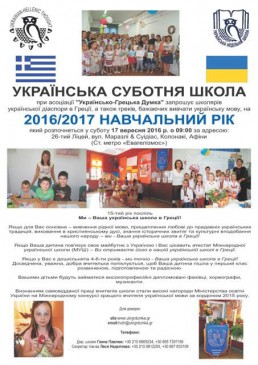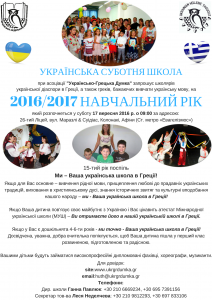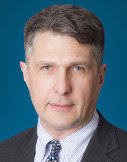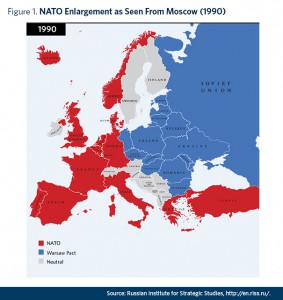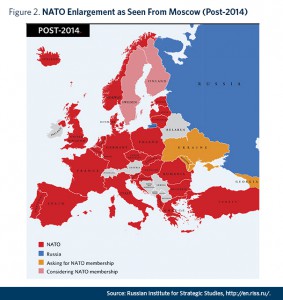Нещасний випадок на Родосі
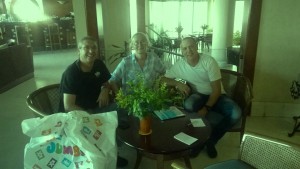 Внаслідок нещасного випадку, який стався у вівторок 4 жовтня 2016 року у відкритому морі зі східної сторони грецького острова Родос на українському торговому судні «Святогор», на сигнал «SOS» вертоліт грецьких військових повітряних сил перевіз 4-рьох українських моряків до лікарні міста Родоса. До великого нещастя один з моряків Ігор Іванов помер по дорозі до лікарні, інший моряк, Сергій Комаров, перебував у комі до четверга 13-го жовтня. В даний момент грецькі лікарі готують Сергія до переведення у терапевтичне відділення. Двоє інших українських моряків, Максим Грідньов і Максим Хмельов, у вівторок 11-го жовтня повернулися на батьківщину.
Наталя Жовква, голова філії товариства «Українсько-Грецька Думка» на о. Родос згуртувала членів українського осередку та друзів, які і словом, і ділом підтримали українців у цю скрутну хвилину.
Щиро дякуємо усім небайдужим, які перейнялися долею молодих людей з України, зокрема, пп. Наталі Жовкві, Мирославі Приймі та Андрію Слебедюку, а також грецькому другу Арістідісу Саламастракісу та пані Асі з Болгарії.
Внаслідок нещасного випадку, який стався у вівторок 4 жовтня 2016 року у відкритому морі зі східної сторони грецького острова Родос на українському торговому судні «Святогор», на сигнал «SOS» вертоліт грецьких військових повітряних сил перевіз 4-рьох українських моряків до лікарні міста Родоса. До великого нещастя один з моряків Ігор Іванов помер по дорозі до лікарні, інший моряк, Сергій Комаров, перебував у комі до четверга 13-го жовтня. В даний момент грецькі лікарі готують Сергія до переведення у терапевтичне відділення. Двоє інших українських моряків, Максим Грідньов і Максим Хмельов, у вівторок 11-го жовтня повернулися на батьківщину.
Наталя Жовква, голова філії товариства «Українсько-Грецька Думка» на о. Родос згуртувала членів українського осередку та друзів, які і словом, і ділом підтримали українців у цю скрутну хвилину.
Щиро дякуємо усім небайдужим, які перейнялися долею молодих людей з України, зокрема, пп. Наталі Жовкві, Мирославі Приймі та Андрію Слебедюку, а також грецькому другу Арістідісу Саламастракісу та пані Асі з Болгарії.
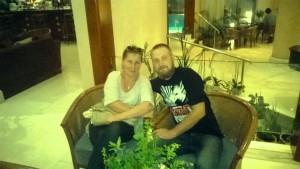

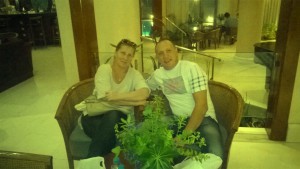
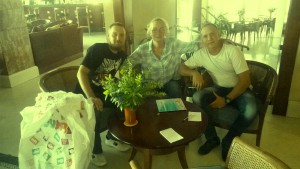
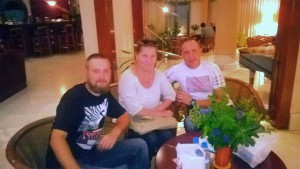
Проект See Ukraine в Афінах. Перезапуск
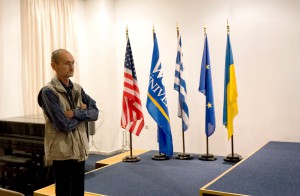 Фестиваль завершили, а я все не встигаю написати кілька слів подяки всім, хто долучився - до проведення та перегляду. Було справді дуже корисно і цікаво.
Величезна подяка Університету Webster за чудове приміщення, Посольству України, що підставили плече у скрутну хвилину, всім цікавим людям - режисерам, аналітикам, модераторам, що взяли участь у дискусіях та показах, перекладачам та технікам, глядачам, які мали багато питань і зробили дискусії та обговорення жвавими та цікавими.
Але особливу вдячність хотілося би висловити команді, яка безпосередньо, з дня в день, працювала задля найкращого результату, а саме координаторці проекту See Ukraine: Docudays UA in Tour Юлі Сердюковій, піар-менеджеру проекту Олі Бірзул, а також грецьким координаторам - Ганні Маніаті, Лесі Неделчевій, Іоанні Теліаніді.
Щиро вдячні режисеру Остапу Костюку за фільм "Жива ватра", яким ми завершили фестиваль в Афінах, та цікаву дискусію після показу. Не дивно, що стрічка завоювала стільки відзнак, там кожний кадр - унікальний. Теплою та щирою була розмова, важко було розійтися.
Приємно, що багато людей пропонували в якийсь спосіб повторити покази, на яких не змогли побувати, що ми й намагатимемось зробити. Адже всі стрічки були дуже різними і показували Україну, якої ми ніколи не бачили. Це надзвичайно цікаво! І як зазначила у своєму коментарі Юля Сердюкова, це варто робити задля тих дискусій, які слідують після показу. Саме так і зробимо.
Фестиваль завершили, а я все не встигаю написати кілька слів подяки всім, хто долучився - до проведення та перегляду. Було справді дуже корисно і цікаво.
Величезна подяка Університету Webster за чудове приміщення, Посольству України, що підставили плече у скрутну хвилину, всім цікавим людям - режисерам, аналітикам, модераторам, що взяли участь у дискусіях та показах, перекладачам та технікам, глядачам, які мали багато питань і зробили дискусії та обговорення жвавими та цікавими.
Але особливу вдячність хотілося би висловити команді, яка безпосередньо, з дня в день, працювала задля найкращого результату, а саме координаторці проекту See Ukraine: Docudays UA in Tour Юлі Сердюковій, піар-менеджеру проекту Олі Бірзул, а також грецьким координаторам - Ганні Маніаті, Лесі Неделчевій, Іоанні Теліаніді.
Щиро вдячні режисеру Остапу Костюку за фільм "Жива ватра", яким ми завершили фестиваль в Афінах, та цікаву дискусію після показу. Не дивно, що стрічка завоювала стільки відзнак, там кожний кадр - унікальний. Теплою та щирою була розмова, важко було розійтися.
Приємно, що багато людей пропонували в якийсь спосіб повторити покази, на яких не змогли побувати, що ми й намагатимемось зробити. Адже всі стрічки були дуже різними і показували Україну, якої ми ніколи не бачили. Це надзвичайно цікаво! І як зазначила у своєму коментарі Юля Сердюкова, це варто робити задля тих дискусій, які слідують після показу. Саме так і зробимо.
Галина МАСЛЮК.
Світлини Юлі СЕРДЮКОВОЇ, Лесі НЕДНЛЧЕВОЇ, Галини МАСЛЮК.
Проект See Ukraine в Афінах. Перезапуск
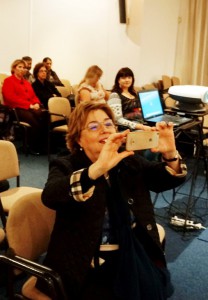
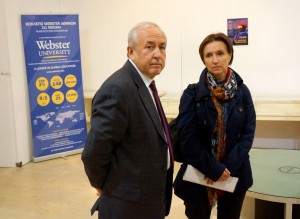
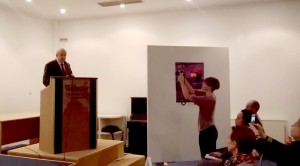
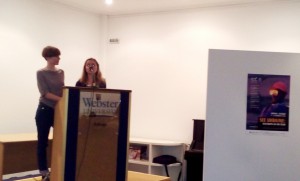
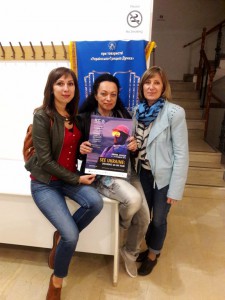
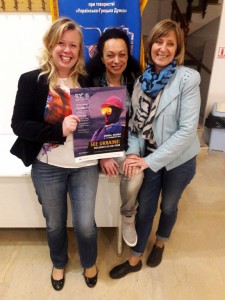
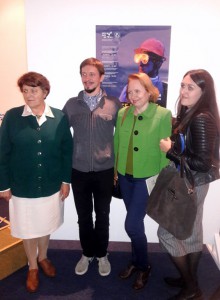
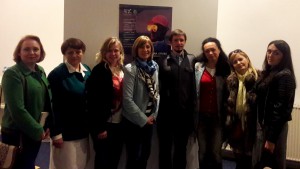
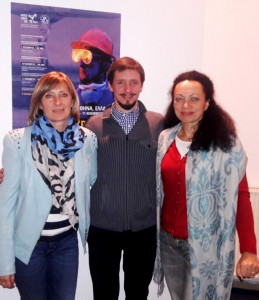
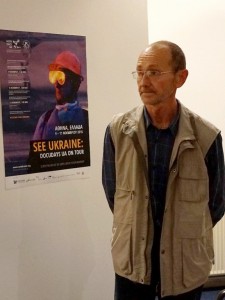
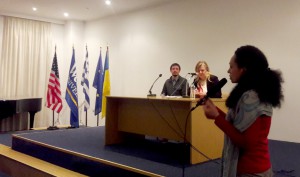
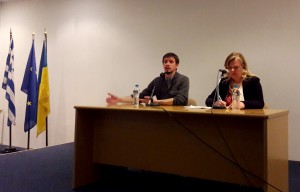
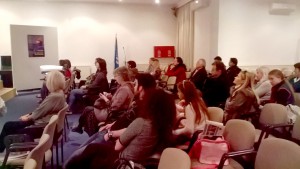
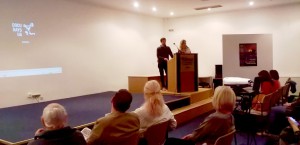
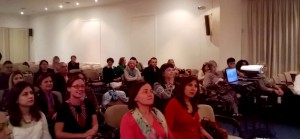
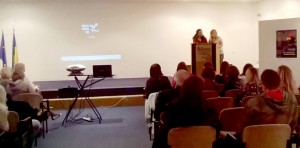
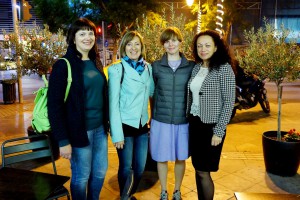
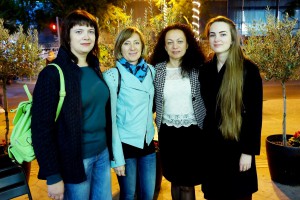
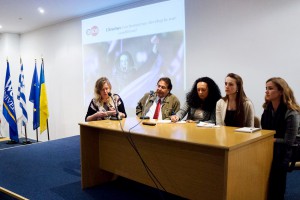
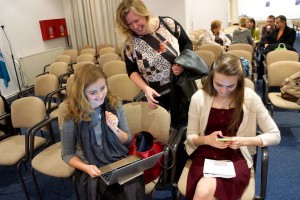
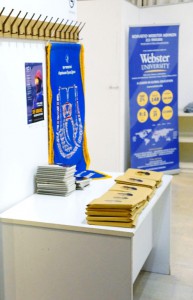
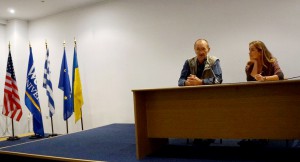
#StopCrimeanTatarGenocide (En)
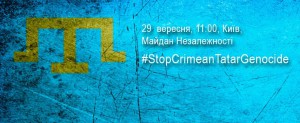 Appeal of Crimean Tatars, representatives of human rights monitoring organizations, Ukrainian and international civil society groups, Members of Parliament of Ukraine, politicians in regard to the prospect of banning of the Mejlis of the Crimean Tatar people
This is a letter of alarm and a call for awakening. Crimean Tatars, the indigenous people of Crimean peninsula and a nation that has been once put on a brink of extinction, are subject to lawless repression by an authoritarian oppressor again. Since the illegal annexation of Crimea by the Russian Federation in 2014, which the absolute majority of Crimean Tatars strongly rejected, the scale of oppression of this nation has only been growing. The political inconvenience that the Crimean Tatars presented for Kremlin was coupled with the historical sentiment of hate that was once aggravated to a point when the entire nation was deported to Central Asia in 1944. The chilling déjà vu started with disallowing the political leaders of the nation Mustafa Dzhemilev and Refat Chubarov to enter the peninsula in the immediate aftermath of the occupation. Then followed the first kidnappings and arrests of Crimean Tatars under falsified pretexts. Simultaneously Crimean Tatars were targeted by the security forces of the Russian Federation based on their religious views. Currently 17 Crimean Tatars are behind the bars for various falsified accusations. Political dissent has been harshly suppressed since the very beginning of the occupation. In spring of 2016 the Deputy Head of the Crimean Tatar Mejlis Mr. Ilmi Umerov became a subject to a politically motivated prosecution by the Russian state, was forcibly taken from the cardiac unit where he was under observation to Psychiatric Hospital No. 1 in Simferopol. The act of punitive psychiatry against Ilmi Umerov that lasted for 21 days clearly disregarded the European Convention for the Prevention of Torture and Inhuman or Degrading Treatment or Punishment. Mr. Umerov is a second Deputy Head of the Crimean Tatar Mejlis to be persecuted by the Russian state with Mr. Akhtem Chiygoz was arrested in January, 2015.
February, the 15th 2016 marked a new stage of repression of Crimean Tatars. Crimean Tatar Mejlis, the executive body of the highest representative body of the Crimean Tatar People Qurultay was declared an extremist organization and illegal on the territory of Russia. A very telling fact is that the Ministry of Justice of Russian Federation included Mejlis in the list of banned organizations prior to the verdict of the court. If the verdict remains unchanged, 2500 democratically elected representatives of the Crimean Tatars will acquire a status of extremists and will become an automatic target of law-enforcement agencies. Furthermore, tens of thousands of people who contact and work with the members of Mejlis may also be repressed by the state machine. It would not be an overstatement to suggest that under such circumstances merely being a Crimean Tatar is illegal in the eyes of the occupying forces. In fact banning the Mejlis is banning the entire people. The repression machine may go out of control altogether given the fact that no permanent mission of any human rights organization is present in Crimea and there is not a single independent media outlet operating in the peninsula.
The decision has been appealed and the final decision on this case will be announced on September, 29th, 2016 in the Supreme Court of Russian Federation.
Hence we, the undersigned Crimean Tatars, representatives of human rights monitoring organizations, civil society groups, Members of Parliament of Ukraine, politicians call upon the global community to recognize the critical importance of this moment for the fate of the Crimean Tatar people. When an entire nation gets ripped of its democratically elected and the only political representation in 2016 the world shall not remain silent. The diplomatic and economic pressure on Russia must be elevated to a new level. The issue of repression of
Crimean Tatars has to be raised at meetings and negotiations of every profile and an immediate end to the repressions must be demanded from the Russian leadership. Concerted efforts of democratic countries have proven to have an influence on Kremlin in the past.
On September, 29th, the day of the hearing of the appeal in the Supreme Court of The Russian Federation, at 11 am (UTC +3) we will hold a demonstration at Independence Square in Kyiv, where we will demand an unconditional end of repressions against Crimean Tatars, display solidarity with the currently persecuted representatives of the nation and affirm the Russian leadership that together with the global community we will not allow another attempt of genocide of Crimean Tatar people.
We encourage regular citizens, civil activists, politicians, diplomats and opinion leaders to show unity with our struggle by coming to the Russian Embassy in countries across the globe and hold a simultaneous demonstration on September, 29th. We kindly ask to use hashtag #StopCrimeanTatarGenocide when covering the simultaneous demonstration in social media.
Appeal of Crimean Tatars, representatives of human rights monitoring organizations, Ukrainian and international civil society groups, Members of Parliament of Ukraine, politicians in regard to the prospect of banning of the Mejlis of the Crimean Tatar people
This is a letter of alarm and a call for awakening. Crimean Tatars, the indigenous people of Crimean peninsula and a nation that has been once put on a brink of extinction, are subject to lawless repression by an authoritarian oppressor again. Since the illegal annexation of Crimea by the Russian Federation in 2014, which the absolute majority of Crimean Tatars strongly rejected, the scale of oppression of this nation has only been growing. The political inconvenience that the Crimean Tatars presented for Kremlin was coupled with the historical sentiment of hate that was once aggravated to a point when the entire nation was deported to Central Asia in 1944. The chilling déjà vu started with disallowing the political leaders of the nation Mustafa Dzhemilev and Refat Chubarov to enter the peninsula in the immediate aftermath of the occupation. Then followed the first kidnappings and arrests of Crimean Tatars under falsified pretexts. Simultaneously Crimean Tatars were targeted by the security forces of the Russian Federation based on their religious views. Currently 17 Crimean Tatars are behind the bars for various falsified accusations. Political dissent has been harshly suppressed since the very beginning of the occupation. In spring of 2016 the Deputy Head of the Crimean Tatar Mejlis Mr. Ilmi Umerov became a subject to a politically motivated prosecution by the Russian state, was forcibly taken from the cardiac unit where he was under observation to Psychiatric Hospital No. 1 in Simferopol. The act of punitive psychiatry against Ilmi Umerov that lasted for 21 days clearly disregarded the European Convention for the Prevention of Torture and Inhuman or Degrading Treatment or Punishment. Mr. Umerov is a second Deputy Head of the Crimean Tatar Mejlis to be persecuted by the Russian state with Mr. Akhtem Chiygoz was arrested in January, 2015.
February, the 15th 2016 marked a new stage of repression of Crimean Tatars. Crimean Tatar Mejlis, the executive body of the highest representative body of the Crimean Tatar People Qurultay was declared an extremist organization and illegal on the territory of Russia. A very telling fact is that the Ministry of Justice of Russian Federation included Mejlis in the list of banned organizations prior to the verdict of the court. If the verdict remains unchanged, 2500 democratically elected representatives of the Crimean Tatars will acquire a status of extremists and will become an automatic target of law-enforcement agencies. Furthermore, tens of thousands of people who contact and work with the members of Mejlis may also be repressed by the state machine. It would not be an overstatement to suggest that under such circumstances merely being a Crimean Tatar is illegal in the eyes of the occupying forces. In fact banning the Mejlis is banning the entire people. The repression machine may go out of control altogether given the fact that no permanent mission of any human rights organization is present in Crimea and there is not a single independent media outlet operating in the peninsula.
The decision has been appealed and the final decision on this case will be announced on September, 29th, 2016 in the Supreme Court of Russian Federation.
Hence we, the undersigned Crimean Tatars, representatives of human rights monitoring organizations, civil society groups, Members of Parliament of Ukraine, politicians call upon the global community to recognize the critical importance of this moment for the fate of the Crimean Tatar people. When an entire nation gets ripped of its democratically elected and the only political representation in 2016 the world shall not remain silent. The diplomatic and economic pressure on Russia must be elevated to a new level. The issue of repression of
Crimean Tatars has to be raised at meetings and negotiations of every profile and an immediate end to the repressions must be demanded from the Russian leadership. Concerted efforts of democratic countries have proven to have an influence on Kremlin in the past.
On September, 29th, the day of the hearing of the appeal in the Supreme Court of The Russian Federation, at 11 am (UTC +3) we will hold a demonstration at Independence Square in Kyiv, where we will demand an unconditional end of repressions against Crimean Tatars, display solidarity with the currently persecuted representatives of the nation and affirm the Russian leadership that together with the global community we will not allow another attempt of genocide of Crimean Tatar people.
We encourage regular citizens, civil activists, politicians, diplomats and opinion leaders to show unity with our struggle by coming to the Russian Embassy in countries across the globe and hold a simultaneous demonstration on September, 29th. We kindly ask to use hashtag #StopCrimeanTatarGenocide when covering the simultaneous demonstration in social media.#StopCrimeanTatarGenocide (Ua)
 Звернення кримських татар, представників міжнародних та українських правозахисних організацій, представників громадянського суспільства, народних депутатів України та політиків до українських громад закордоном у зв’язку з перспективою заборони Меджлісу кримськотатарського народу на території Росії
Це звернення є сигналом тривоги та закликом до пробудження. Кримські татари, корінний народ Кримського півострова, народ, що колись вже опинявся на межі зникнення, знову став жертвою незаконних репресій з боку авторитарного режиму.
З часу незаконної анексії Криму Росією у 2014 році, яку однозначно не прийняла абсолютна більшість кримських татар, масштаб репресій проти цього народу невпинно зростав. Образ політичної перешкоди Кремлю був примножений історичним почуттям ненависті, яке в свій час призвело до депортації цілого народу до Середньої Азії у 1944 році. Моторошне дежавю тих подій розпочалось з заборони на в’їзд до півострова лідерам кримськотатарського народу Мустафі Джемілєву та Рефату Чубарову невдовзі після окупації. Згодом почалися зникнення та арешти кримських татар, що базувались на надуманих звинуваченнях. В той же час кримських татар почали переслідувати силові органи окупаційної влади на основі їх релігійних переконань. На сьогодні 17 кримських татар перебувають за ґратами. Навесні 2016 р. заступник голови Меджлісу пан Ільмі Умеров став об’єктом політично-упередженого кримінального переслідування з боку Російської держави та був силою переведений з кардіологічного відділу, де він проходив обстеження до психіатричної клініки №1 у місті Сімферополь. Використання каральної психіатрії проти Ільмі Умерова протягом 21 дня було явним порушенням Європейської Конвенції про запобігання катуванням чи нелюдському або такому, що принижує гідність, поводженню чи покаранню.
Пан Умеров є вже другим заступником голови Меджлісу, якого переслідує російська влада – першим у січні 2015 року став пан Ахтем Чийгоз.
15 лютого 2016 року став днем початку нового етапу репресій проти кримських татар. Окупаційна влада оголосила Меджліс кримськотатарського народу – виконавчий орган найвищого представницького органу кримських татар Курултаю – екстремістською організацією та заборонила його діяльність на території Росії. Показовим був той факт, що Міністерство Юстиції Росії внесло Меджліс до списку екстремістських (а отже заборонених) організації ще до вироку суду. В разі, якщо вердикт залишиться у силі, як мінімум 2500 демократично-обраних представників кримськотатарського народу отримають статус екстремістів та автоматично стануть об’єктом переслідувань з боку російських правоохоронних органів. Більше того, десятки тисяч людей, що співпрацюють чи комунікують з представниками Меджлісу також можуть бути репресованими. Не буде перебільшенням ствердити, що за таких умов бути кримським татарином – уже злочин в очах окупаційної влади. Фактично заборона Меджлісу є забороною цілого народу. Репресивна машина може узагалі вийти з-під контролю, враховуючи відсутність у Криму постійних моніторингових місій з прав людини чи незалежних ЗМІ. На рішення про заборону Меджлісу була подана апеляція і остаточне рішення у цій справі буде прийняте 29 вересня 2016 року у Верховному Суді Росії.
Тому ми – кримські татари, представники міжнародних та українських правозахисних організацій, представники громадянського суспільства, народні депутати України та політики закликаємо світову спільноту усвідомити виняткову важливість цього
моменту для долі кримськотатарського народу. Коли у цілої нації відбирають право на демократично-обране та єдине політичне представництво у 2016 році, світ не повинен мовчати. Дипломатичний та економічний тиск на Росію має вийти на новий рівень. Питання репресій проти кримських татар має порушуватись на зустрічах та переговорах усіх рівнів. Миттєве припинення репресій проти кримських татар має бути вимогою російському керівництву. Об’єднані зусилля демократичних держав вже неодноразово доводили свою впливовість у переговорах з керівництвом Росії.
29 вересня, у день розгляду апеляції у Верховному Суді Росії, об 11:00 ранку ми проводитемо демонстрацію на Майдані Незалежності в Києві. Під час демонстрації ми вимагатимемо невідкладного припинення репресій проти кримських татар, проявимо солідарність з тими кримськими татарами, що піддаються переслідуванню зараз та запевнимо керівництво Росії, що спільно з світовою спільнотою ми не допустимо повторення спроби геноциду кримськотатарського народу. Ми запрошуємо українців з усього світу проявити єдність у боротьбі та прийти до Російського Посольства у країнах їх проживання для проведення паралельної демонстрації 29 вересня 2016 року. При висвітленні синхронних акцій в соціальних мережах просимо використовувати хештег #StopCrimeanTatarGenocide
Звернення кримських татар, представників міжнародних та українських правозахисних організацій, представників громадянського суспільства, народних депутатів України та політиків до українських громад закордоном у зв’язку з перспективою заборони Меджлісу кримськотатарського народу на території Росії
Це звернення є сигналом тривоги та закликом до пробудження. Кримські татари, корінний народ Кримського півострова, народ, що колись вже опинявся на межі зникнення, знову став жертвою незаконних репресій з боку авторитарного режиму.
З часу незаконної анексії Криму Росією у 2014 році, яку однозначно не прийняла абсолютна більшість кримських татар, масштаб репресій проти цього народу невпинно зростав. Образ політичної перешкоди Кремлю був примножений історичним почуттям ненависті, яке в свій час призвело до депортації цілого народу до Середньої Азії у 1944 році. Моторошне дежавю тих подій розпочалось з заборони на в’їзд до півострова лідерам кримськотатарського народу Мустафі Джемілєву та Рефату Чубарову невдовзі після окупації. Згодом почалися зникнення та арешти кримських татар, що базувались на надуманих звинуваченнях. В той же час кримських татар почали переслідувати силові органи окупаційної влади на основі їх релігійних переконань. На сьогодні 17 кримських татар перебувають за ґратами. Навесні 2016 р. заступник голови Меджлісу пан Ільмі Умеров став об’єктом політично-упередженого кримінального переслідування з боку Російської держави та був силою переведений з кардіологічного відділу, де він проходив обстеження до психіатричної клініки №1 у місті Сімферополь. Використання каральної психіатрії проти Ільмі Умерова протягом 21 дня було явним порушенням Європейської Конвенції про запобігання катуванням чи нелюдському або такому, що принижує гідність, поводженню чи покаранню.
Пан Умеров є вже другим заступником голови Меджлісу, якого переслідує російська влада – першим у січні 2015 року став пан Ахтем Чийгоз.
15 лютого 2016 року став днем початку нового етапу репресій проти кримських татар. Окупаційна влада оголосила Меджліс кримськотатарського народу – виконавчий орган найвищого представницького органу кримських татар Курултаю – екстремістською організацією та заборонила його діяльність на території Росії. Показовим був той факт, що Міністерство Юстиції Росії внесло Меджліс до списку екстремістських (а отже заборонених) організації ще до вироку суду. В разі, якщо вердикт залишиться у силі, як мінімум 2500 демократично-обраних представників кримськотатарського народу отримають статус екстремістів та автоматично стануть об’єктом переслідувань з боку російських правоохоронних органів. Більше того, десятки тисяч людей, що співпрацюють чи комунікують з представниками Меджлісу також можуть бути репресованими. Не буде перебільшенням ствердити, що за таких умов бути кримським татарином – уже злочин в очах окупаційної влади. Фактично заборона Меджлісу є забороною цілого народу. Репресивна машина може узагалі вийти з-під контролю, враховуючи відсутність у Криму постійних моніторингових місій з прав людини чи незалежних ЗМІ. На рішення про заборону Меджлісу була подана апеляція і остаточне рішення у цій справі буде прийняте 29 вересня 2016 року у Верховному Суді Росії.
Тому ми – кримські татари, представники міжнародних та українських правозахисних організацій, представники громадянського суспільства, народні депутати України та політики закликаємо світову спільноту усвідомити виняткову важливість цього
моменту для долі кримськотатарського народу. Коли у цілої нації відбирають право на демократично-обране та єдине політичне представництво у 2016 році, світ не повинен мовчати. Дипломатичний та економічний тиск на Росію має вийти на новий рівень. Питання репресій проти кримських татар має порушуватись на зустрічах та переговорах усіх рівнів. Миттєве припинення репресій проти кримських татар має бути вимогою російському керівництву. Об’єднані зусилля демократичних держав вже неодноразово доводили свою впливовість у переговорах з керівництвом Росії.
29 вересня, у день розгляду апеляції у Верховному Суді Росії, об 11:00 ранку ми проводитемо демонстрацію на Майдані Незалежності в Києві. Під час демонстрації ми вимагатимемо невідкладного припинення репресій проти кримських татар, проявимо солідарність з тими кримськими татарами, що піддаються переслідуванню зараз та запевнимо керівництво Росії, що спільно з світовою спільнотою ми не допустимо повторення спроби геноциду кримськотатарського народу. Ми запрошуємо українців з усього світу проявити єдність у боротьбі та прийти до Російського Посольства у країнах їх проживання для проведення паралельної демонстрації 29 вересня 2016 року. При висвітленні синхронних акцій в соціальних мережах просимо використовувати хештег #StopCrimeanTatarGenocide
Ο υβριδικός πόλεμος της Ρωσίας ενάντια στην Ουκρανία
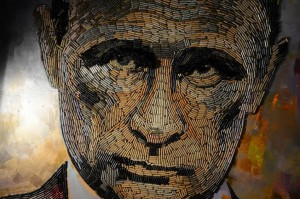 Διάβασα ένα άρθρο-ανασκόπηση του Γιούρι Ρομανένκο και του Σ. Κλιμόβσκιϋ «Ο πρώτος υβριδικός. Πότε η Ρωσία άρχισε τον πόλεμο εναντίον της Ουκρανίας;». Μια λεπτομερής ανάλυση των γεγονότων του παρελθόντος, μεμονωμένοι συμμετέχοντες του οποίου σήμερα δεν είναι μόνο ζωντανοί, αλλά και ενεργοί. Για το λογαριασμό τους θα ήθελα να κάνω κάποιες διευκρινήσεις.
Η αρχή του υβριδικού πολέμου της Ρωσίας εναντίον της Ουκρανίας χρονολογείται αρκετά ακριβή: 30 Νοεμβρίου του 1991 – τότε από την Ουκρανία υπέρ του Ταμιευτηρίου της ΕΣΣΔ και του Υπουργείου Οικονομικών της Ρώσικης Ομοσπονδίας είχαν διαγραφεί 81.900 διςεκατομμύρια ρούβλια.
Θα μπορούσε να φέρει αντίρρηση κανείς ότι εκείνη την εποχή η Ουκρανία δεν είχε επίσημη ανεξαρτησία. Τότε πρέπει να ξεκινήσουμε την καταμέτρηση από την 8η Δεκεμβρίου 1991 - την ημερομηνία υπογραφής των συμφωνιών του Μπελοβέζ.
Διαβάστε περισσότερα: http://www.analystsforchange.org/2016/07/blog-post_296.html
Διάβασα ένα άρθρο-ανασκόπηση του Γιούρι Ρομανένκο και του Σ. Κλιμόβσκιϋ «Ο πρώτος υβριδικός. Πότε η Ρωσία άρχισε τον πόλεμο εναντίον της Ουκρανίας;». Μια λεπτομερής ανάλυση των γεγονότων του παρελθόντος, μεμονωμένοι συμμετέχοντες του οποίου σήμερα δεν είναι μόνο ζωντανοί, αλλά και ενεργοί. Για το λογαριασμό τους θα ήθελα να κάνω κάποιες διευκρινήσεις.
Η αρχή του υβριδικού πολέμου της Ρωσίας εναντίον της Ουκρανίας χρονολογείται αρκετά ακριβή: 30 Νοεμβρίου του 1991 – τότε από την Ουκρανία υπέρ του Ταμιευτηρίου της ΕΣΣΔ και του Υπουργείου Οικονομικών της Ρώσικης Ομοσπονδίας είχαν διαγραφεί 81.900 διςεκατομμύρια ρούβλια.
Θα μπορούσε να φέρει αντίρρηση κανείς ότι εκείνη την εποχή η Ουκρανία δεν είχε επίσημη ανεξαρτησία. Τότε πρέπει να ξεκινήσουμε την καταμέτρηση από την 8η Δεκεμβρίου 1991 - την ημερομηνία υπογραφής των συμφωνιών του Μπελοβέζ.
Διαβάστε περισσότερα: http://www.analystsforchange.org/2016/07/blog-post_296.html
Russia and the Security of Europe (En)
Summary: Russia’s annexation of Crimea in March 2014 was the latest step in Moscow’s long process of rejection of the post–Cold War Euro-Atlantic security order, reflecting a deeply held view that is unlikely to change anytime soon. Western strategy will need to adjust to Russia’s conception of its interests and priorities in and around Europe.
The Return of Geopolitics
- Russian elites are guided by a deep-seated sense of vulnerability vis-à-vis the West and fear Western encroachment on the country’s security, economic, and geopolitical interests, as well as on their hold on power in Russia.
- The perception of vulnerability vis-à-vis the West includes every aspect of Russia’s economy, politics, and defense. It is reinforced by Russian elites’ concerns about the internal weakness of the country and its direction. It also serves as a tool for the elites to mobilize the population in the face of external threats. The elites recognize that the country is in a systemic crisis but fear that solutions could prove destabilizing.
- The lack of confidence in their defense capabilities has led Russian military experts to consider strategies for early nuclear escalation as a deterrent and countermeasure to the West’s perceived conventional superiority. The West’s plans for improving conventional capabilities and missile defenses are eroding Russian military planners’ confidence in their nuclear deterrent.
- As seen by Russia’s national security establishment and political elites, the security environment along the periphery of Russia is precarious and adds to the internal challenges facing the country. Russian planners are being confronted with a region rife with instability, local conflicts, and foreign powers they view as competing with or openly hostile to Russia in every strategic direction.
- In this environment, Russia is resorting to an array of tools from nuclear saber rattling to intimidation of smaller, weaker neighbors to information warfare, cyberoperations, subversion, bribery, and other political and economic measures as means of hybrid warfare or continuation of politics by all available means.
Implications for Western Policy
- The experiences of Ukraine and Georgia have profound implications for not only those countries but also Armenia, Azerbaijan, Belarus, and Moldova. Lacking the North Atlantic Treaty Organization’s (NATO’s) security guarantee, these six battleground states remain in what Moscow perceives as its sphere of privileged interests. It is prepared to use military force to keep them in it. As the West is not prepared to consign these states to the Russian sphere, they become the arena for East-West competition.
- Russian actions before, during, and since the aggression against Ukraine suggest that Moscow still takes NATO’s Article 5 security guarantee of its members seriously, and that it is not prepared to test that guarantee directly. Russian leaders went to war twice to prevent Georgia and Ukraine from eventually—as they saw it—joining NATO. Rather than challenge NATO directly, Moscow will continue to rely on its wide array of hybrid warfare methods to undermine member states’ confidence in the alliance.
- Western policymakers should have no illusions that the buildup of defense and deterrent capabilities in the frontline states will have a stabilizing effect on the standoff between NATO and Russia. NATO’s actions in the aftermath of the Ukraine crisis, intended to shore up the frontline states, have triggered disproportionate Russian responses, including deployment of anti-access and area-denial (A2/AD) capabilities to Crimea and Kaliningrad as well as threats to deploy nuclear weapons there.
- Absent major changes in Russia’s (or NATO’s) outlook, this adversarial relationship will remain a key feature of the Euro-Atlantic security order for the foreseeable future. Eventually, it will take a political, not a military, solution to resolve this standoff.
Introduction
The annexation of Crimea by Russia in March 2014 and the undeclared war against Ukraine that followed marked the end of the post–Cold War period in European history. Russian actions have destroyed key elements of both the post–Cold War security system and the post–World War II security system in Europe that had survived for nearly three-quarters of a century. The damage done by Russian actions is deep and lasting, with pre- and post-Ukraine embodying a clear dividing line in European security affairs. A new geopolitical division of Europe has emerged as well. Putting the pieces back together in Ukraine and shoring up a united Europe will stretch U.S. capabilities. These twin challenges will remain a strategic imperative for U.S. policymakers absent a major shift in Russian positions with respect to European security—a highly unlikely occurrence without a change in the country’s leadership and governing ideology.
Russian actions in Ukraine and elsewhere in Europe have shocked both European and U.S. national security and foreign policy establishments. Few, if any, analysts on either side of the Atlantic had predicted that Moscow would move to destroy what was envisioned at the end of the Cold War as Europe whole, free, and at peace with itself and its neighbors.1 Russian actions against Ukraine came as a surprise even for many seasoned Russian foreign policy observers.2 The decision to seize and subsequently annex Crimea and to launch the war in eastern Ukraine in support of Russian-inspired separatists was most likely part of a spontaneous, panicky response by Moscow to the rapidly changing political environment in Ukraine rather than an element of a long-term, well-thought-out, deliberate strategy.3
However, a careful examination of Russia’s own narrative about European and Eurasian security, and its evolution since the end of the Cold War, suggests that Russian actions in Ukraine were entirely logical, perhaps even inevitable, as an extension of Russian threat perceptions. As seen from Moscow, the rapid changes in Ukrainian politics—the collapse of the presidency of Viktor Yanukovych and the coming to power of a political coalition advocating Ukraine’s pro-European and Euro-Atlantic orientation, including eventual membership in the European Union (EU) and the North Atlantic Treaty Organization (NATO)—carried with them profound geopolitical consequences for Russia: they signaled the emergence of new threats to Russia’s security right at its doorstep, threats that no Russian leader is likely to tolerate without a wholesale change in the country’s ideology and understanding of its national security.
From Moscow’s perspective, its actions in Ukraine represented quintessentially a series of necessary defensive, rather than offensive and expansionist, measures that were intended to prevent an even more severe geopolitical imbalance on the continent resulting from NATO and EU expansion into Central and Eastern Europe. At the root of these actions was a sense of vulnerability rather than confidence in Moscow’s relations with the West. Ironically, the security environment around the periphery of Russia that has emerged as a result of the annexation of Crimea and the subsequent aggression against Ukraine undoubtedly leaves Russian military planners with a greater sense of vulnerability.
Europe Whole, Free, and at Peace With Itself and Its Neighbors?
The peaceful end of the Cold War and dissolution of the Soviet Union in 1991 signaled the dawn of a new era in European security. After the ideological and military standoff that had divided the continent for more than four decades, Europe—including Russia—was coming together on the basis of a new vision, embraced by all as the foundation for a new security order.
That security order, described by Western leaders as Europe whole, free, and at peace with itself and its neighbors, would not rely on such familiar concepts as balance of power or balance of interests to maintain peace on the continent. It would instead rely on all European nations—including Russia—maintaining a commitment to shared values and adherence to a set of key principles to guide their foreign and security policies. These principles were respecting the independence, sovereignty, and territorial integrity of all nations; refraining from using force to settle international disputes; allowing freedom of choice by all states to pursue their foreign policies and enter into alliances; and demonstrating respect for fundamental human rights and personal freedoms in states’ domestic political arrangements.
None of these commitments undertaken by all European nations—including Russia—were new. They had their antecedents in the United Nations (UN) charter at the end of World War II, as well as more recently in the 1975 Helsinki Final Act.4 As if to underscore their commitments and renew them for the new era, the heads of state or government of all European nations, Canada, and the United States came together in 1990 to sign the Charter of Paris for a New Europe.5 In that document, they welcomed the new era of “democracy, peace and unity in Europe” and, among other things, pledged to “settle disputes by peaceful means” and defend “democratic institutions against activities which violate the independence, sovereign equality or territorial integrity of the participating States.”
The Charter of Paris was joined by the Soviet Union, whose commitments were assumed by Russia upon its dissolution in 1991. Ukraine and other former Soviet states also joined the Organization for Security and Cooperation in Europe, which was established to implement the vision of the Charter of Paris.
Another major step in the evolution of Europe was the signing in 1992 of the Maastricht Treaty.6 It was a milestone in the process of European integration—also on the basis of shared values—that transformed the European Community into the European Union. The EU would pursue the goals of promoting and strengthening democratic institutions, establishing a monetary union, and developing a common foreign and security policy.
The Soviet Union and subsequently Russia played essential roles in this transformation of the European security landscape, having consented to shed the outer and inner empires peacefully in the late 1980s and early 1990s. At the time, both the Soviet government and the government of the new Russian state declared and demonstrated in deed their commitment to uphold the underlying principles of European security and stability.
Early Signs of Trouble
However, while the rest of the continent celebrated the dawn of a new peaceful and harmonious era in European history and embraced the vision of Europe whole, free, and at peace with itself and its neighbors, Russia was having second thoughts. The idea of a European security system based on a vague concept of shared values did not sit well with the Russian foreign policy and security establishment. Thus, speaking at a foreign ministry conference devoted to a discussion of a new foreign policy concept of the Russian Federation, then foreign minister Andrey Kozyrev declared that “Russia must become a normal great power.”7 The chairman of the Foreign Affairs Committee of the Russian Duma, Yevgeniy Ambartsumov, welcomed the foreign minister’s proposal and went further, declaring that the time had come to “abandon idealistic declarations in favor of realpolitik.”8
Although the Russian government was preoccupied at the time with a seemingly endless succession of domestic crises that followed the dissolution of the Soviet Union, including a collapsing economy and fierce political struggle in the Russian parliament, where the reform agenda ran into strong opposition, the Russian foreign policy establishment articulated a more ambitious vision of the state’s interests than the dire state of Russia’s domestic politics and economy might have suggested. In sharp contrast to his earlier conciliatory statements, Ambartsumov explicitly laid claim to Russia’s special rights, even responsibilities, throughout the territories of the former Soviet states and suggested that Russian interests transcended the borders of these newly independent states.9 Sergey Karaganov, a leading foreign policy scholar and founder of the Council on Foreign and Defense Policy, wrote in a similar vein that Russia had not just a set of interests, but a special mission—a “heavy cross” to bear—in the territories of the former Soviet Union.10
Russia had inherited its national security establishment from the Soviet Union. Ambartsumov, Kozyrev, and Karaganov represented a new generation of foreign policy thinkers and practitioners with relatively progressive attitudes who could have been expected to hold more enlightened views on relations with neighboring states and the post–Cold War security arrangements in Europe. But the Russian military, security services, and diplomatic establishment were all products of the Cold War in which mistrust of the West was deep and not easily overcome by declarations of peaceful intentions by European and U.S. leaders.11
These early signals that shared values may not be sufficient for Russia as the basis for European security and stability could have remained a largely inconsequential discourse in the relatively narrow and self-contained community of Russian foreign policy experts. Foreign policy in the 1990s took a backseat to domestic affairs, especially the economy, which was the dominant concern of the country’s elites and the general public. However, the debate was brought to the fore of Russian domestic politics and European discussions about the continent’s security architecture by two critically important processes: enlargement of the EU and NATO.
The first major encounter signaling future troubles took place in 1993. During an August meeting with then Polish president Lech Wałęsa in Warsaw, then Russian president Boris Yeltsin in a written statement expressed his “understanding” of Poland’s desire to join NATO.12 Kozyrev reportedly echoed that sentiment despite having been opposed to the idea previously. However, just a few weeks later, in October 1993, the Russian president sent a letter to then U.S. president Bill Clinton stating his strong opposition to membership in the alliance for Poland or any other Central or Eastern European country.13 Yeltsin’s apparent change of position was reportedly due to pressure from the Russian military establishment, which still considered NATO a threat.14
The launch of an active discussion in Europe and the United States about NATO enlargement transformed the initial cracks in the European security landscape into a major divide between Russia and most of the rest of Europe. NATO allies and aspirants maintained that expanding the alliance was intended not as a hostile step against Russia, but that bringing the zone of stability and security closer to Russia’s border would only benefit Moscow. Russian counterarguments were precisely the opposite, stressing the military capabilities that NATO expansion would inevitably bring closer to Russian borders. (See Russian government think tank maps showing NATO enlargement in figures 1 and 2.)
Russian opposition to NATO enlargement was shared by politicians across the political spectrum. The conservative wing of Russian politics represented by the nationalists and the Communists opposed the alliance’s expansion for geopolitical and ideological reasons. The liberals and reformers opposed it because they saw it as damaging to their already tenuous position in Russian domestic politics, vulnerable to criticism from opponents who accused them of betraying Russian national interest and being agents of the West.15
The values-based approach to European security was failing to get recognition in Russia for several reasons: after nearly three-quarters of a century under an ideologically driven and failed regime, the population had little confidence in ideas in general; this mistrust was reinforced by the new Russian government’s failure to deliver and demonstrate to the public the tangible benefits of the new ruling ideology of the market and democracy, as the country limped from one crisis to the next.
After being cut off from Western political science for decades, Russian international relations scholars were avidly absorbing ideas put forth by leading Western political scientists. The most prominent among them were Samuel Huntington and Zbigniew Brzezinski, whose books The Clash of Civilizations and the Remaking of World Order and The Grand Chessboard respectively approached contemporary international relations from points of view that rejected the very idea of a values-based security system in Europe and Eurasia.16 Huntington’s volume, as the title suggests, predicted a conflict pitting Western civilization and its liberal ideology against other civilizations guided by other ideas. Brzezinski argued that it was important for the United States to prevent another major power—read Russia—from dominating the Eurasian landmass.
The Russian government vehemently opposed NATO’s intervention in Yugoslavia as, among other reasons, a potential precedent for similar action by NATO in Russia or around its periphery.18
In light of these two books by leading American foreign policy thinkers widely regarded in Russia as speaking for Washington’s foreign policy establishment, it was easy for Russian foreign and national security policymakers, many of them products of the Cold War, to be skeptical of U.S. and allies’ reassurances about values-based security arrangements for Europe and Eurasia. While the idea of NATO extending its membership beyond Europe was not brought up even in the most ambitious discussions of the alliance’s future at the time, NATO did extend its reach into Central Asia through its Partnership for Peace program.17 That could have been interpreted by Russian military planners as a maneuver to encircle Russia, notwithstanding the fact that Russia itself had joined the Partnership for Peace.
Another factor shaping Russian threat perceptions with respect to NATO and European security was the conflict in the former Yugoslavia. For Russia, still reeling from the dissolution of the Soviet Union and struggling to overcome multiple political and economic challenges, the violent breakup of Yugoslavia was a continuing reminder of the dangers it had barely escaped. The Russian government vehemently opposed NATO’s intervention in Yugoslavia as, among other reasons, a potential precedent for similar action by NATO in Russia or around its periphery.18 The Russian military’s brutal tactics during the 1994–1996 war in Chechnya drew widespread condemnation from the West. The possibility of a NATO intervention in the breakaway republic, no matter how improbable to most seasoned observers, was nonetheless widely discussed in Russia.19
The argument put forth by the West that NATO’s intervention in Yugoslavia was motivated by humanitarian considerations only reinforced Russian opposition to the campaign and resistance to NATO’s enlargement. From the standpoint of Russian national security planners, the extradition and trial of the former Yugoslav strongman Slobodan Milošević undoubtedly served as a reminder that at some future time a weakened Russian government could be forced to surrender the leaders of the military campaign in Chechnya and that they would find themselves on trial for war crimes before an international tribunal.20
From the standpoint of Russian national security planners, the only guarantee against such events was the vast nuclear arsenal Russia had inherited from the Soviet Union. Russian national security documents from the 1990s onward have stressed the unique role of nuclear weapons as the ultimate—perhaps even the only—guarantee of Russian sovereignty and strategic independence.21
But although nuclear weapons were indispensable as a guarantee against Western intervention in Russia, they were far less useful when it came to intervening in crises beyond Russia’s borders and projecting Moscow’s interests beyond the borders. The nuclear arsenal was of little use when it came to deterring NATO enlargement ever closer to Russian borders and securing a sphere of influence for Russia around its periphery—a long-standing Russian objective articulated as early as 1992 by leading Russian foreign policy thinkers and practitioners. For that, Russia would have to rebuild its conventional capabilities, which in turn would require a commitment of significant economic resources.
A Strong Warning
During the first decade of the twenty-first century, Russia enjoyed a major economic rebound. In the decade from the financial collapse of 1998 to the end of Vladimir Putin’s second presidential term in 2008, Russian gross domestic product (GDP) grew from just under $300 billion to nearly $1.7 trillion in current prices.22 As the economy rebounded and domestic politics stabilized, the Russian government assumed a far more prominent position in the international arena than during the 1990s. Russia became a full-fledged member of the G8 industrialized economies and asserted itself as a strong and independent voice on major issues, from European security to the war in Iraq.
The most notable and forceful statement on foreign and security policy from that period came from Putin personally, delivered at the Munich Security Conference in 2007. The speech, described by some in the audience as Cold War–like, clearly laid out Russian rejection of the post–Cold War security order in Europe.23 The Russian president characterized NATO enlargement as a provocative unilateral landgrab by the U.S.-led alliance seeking to expand its sphere of influence. In putting its military forces right up to Russia’s border, Putin said, NATO was in violation of assurances given to Russia at the end of the Cold War. This unilateral, unipolar, U.S.-centric security model, he concluded, was unacceptable.
Moreover, according to the narrative widely held in Russia’s national security establishment, NATO enlargement was not only a landgrab that upset the geopolitical balance in Europe, but it also constituted a violation of assurances given by Western leaders to then Soviet president Mikhail Gorbachev that in exchange for Germany’s reunification and NATO membership, the alliance would not expand eastward.24 The nature of this claim has been repeatedly disputed.25 And documentary evidence to support it has been ambiguous at best—to say nothing of its practical irrelevance, for nobody, not even Russian officials, proposes to undo NATO enlargement. Still, the idea that the West broke its promise has become an integral part of Russian discussions about post–Cold War security in Europe.
The Russian president characterized NATO enlargement as a provocative unilateral landgrab by the U.S.-led alliance seeking to expand its sphere o f influence.
Russian leaders opposed Europe’s post–Cold War security order also on ideological grounds. They criticized U.S. and European efforts to promote democracy around the periphery of Russia as a thinly disguised pursuit of the West’s expanded sphere of influence.26 They also viewed the efforts as a deeply destabilizing undertaking that threatened the stability and security of neighboring states and even held out the possibility of undermining Russia’s own hard-won domestic stability. Beyond that, the push by the West to promote democracy inside Russia was declared by Russian leaders as a violation of Russian sovereignty and potentially destabilizing and deeply threatening to the Putin administration itself.
As Russia’s own domestic politics took on a more authoritarian turn and Putin consolidated more power, he came under criticism from Western leaders.27 Combined with enthusiastic Western expressions of support for the Rose Revolution in Georgia in 2003 and the Orange Revolution in Ukraine in 2004–2005—both crises in which Russia and the West were pitted against each other through proxy factions—the West’s support for democracy through the ever-expanding reach of the EU and NATO emerged as the most contentious issue in relations with Russia. Building on the major theme of his Munich address, Putin delivered a further warning to NATO at the alliance’s 2008 Bucharest summit. NATO’s promise of future membership to Georgia and Ukraine, he said, constituted a “direct threat” to Russian security. In an ominous preview of future events, he spoke of the historic ties between Russia and the ethnic Russian populations of eastern Ukraine and Crimea and the population’s desire for close ties with the motherland.28
As if the Russian president’s two warnings were not enough, the war with Georgia in 2008 sent a further message to the West, as well as to Russia’s neighbors, that Putin meant what he said. In a statement on Russian television in the immediate aftermath of the war in Georgia, then president Dmitry Medvedev declared countries around Russia’s periphery as a sphere of Russia’s “privileged” interests.29 No statement delivered by a Russian leader prior to the war of 2008 had signaled with greater clarity Moscow’s rejection of a values-based security system in Europe. Medvedev would divide the continent into spheres of interests and influence, and he was fully committed to defend Russia’s sphere from encroachment by other powers.
The war in Georgia delivered two very distinct messages to two different audiences. To the West, the message was to stay out of the sphere of Russia’s privileged interests. To Russia, the message was that despite the successful campaign against its tiny neighbor, the Russian military was in need of far-reaching reform.30 Russia needed the capability beyond its nuclear arsenal to defend its interests and deter those who might consider infringing on them. The military reform launched in the aftermath of the war in Georgia and a program of military modernization were intended to give Russia the capability to do just that.31
The Break
The 2008–2012 interregnum between Putin’s second and third terms as president was a period of relative calm in Russia’s relations with the West. Combined with the reset with Russia beginning in 2009 by the administration of U.S. President Barack Obama, other imperatives—the war in Afghanistan, Iran’s nuclear program, the crisis in Libya—took precedence over NATO enlargement. At the same time, newly launched debates inside Russia about domestic political and economic modernization held out the prospect of Russia returning to the path of democratization and a more cooperative relationship with the West.32 In addition, NATO lacked the necessary consensus to push for Georgia’s membership in the alliance in the aftermath of the war of 2008. And in 2010, Ukraine removed NATO membership from its list of national security priorities altogether.33
The calm was broken by developments inside Russia. Putin’s decision to reclaim the presidency from Medvedev was met with large-scale protests—unprecedented in the history of modern Russia—by proponents of further political and economic reforms that had been debated during Medvedev’s presidency.34 The protests were greeted in the West as a manifestation of Russia’s democratic spirit and political reawakening.35
The response from the Putin administration was harsh. It included a series of new legislative steps to limit the Russian public’s space for political protests; court actions against protesters; and a media campaign accusing the West of instigating protests in Russia to undermine and weaken it.36 The West was promoting in Russia values that were alien to Russian society, the Kremlin charged, embracing the slogan “Russia is not Europe.”37 Putin’s third term began with a clear juxtaposition of Russia vs. the West as a conflict driven by different values systems. Two decades after signing on to the vision of Europe whole, free, and at peace with itself and its neighbors, Russia finally abandoned it.
Putin’s third term began with a clear juxtaposition of Russia vs. the West as a conflict driven by different values systems.
This break also manifested itself in Russian foreign policy, particularly in relations with the former Soviet states. Building on earlier Russian pronouncements about a sphere of influence and interests, and the danger posed by the West’s geopolitical expansion, Putin elevated Eurasian integration—the gathering of the former Soviet states around Russia—to the top of his foreign policy agenda for his third term.38 Building on the Russia-Kazakhstan-Belarus customs union established in 2000, Putin proposed to move toward a “Common Economic Space,” eventually proceeding to a political—Eurasian—union, all vaguely patterned on the EU and rather transparently intended to create a regional counterweight to it. In Putin’s words, the Eurasian union would become a “powerful supranational association capable of becoming one of the poles in the modern world”—a reference to the long-standing Russian preference for a multipolar international system and rejection of the U.S.-dominated unipolar world.39
Putin’s policy of Eurasian integration stood in direct conflict with the EU’s European Neighborhood Policy, which is intended to bring countries on the EU’s eastern borders closer to it by offering them Association Agreements.40 These agreements are designed to promote political, economic, and rule-of-law reforms in countries of Eastern Europe and encourage their closer political and commercial ties to the EU. Several Eastern European countries—Armenia, Georgia, Moldova, and Ukraine—were in the process of negotiating Association Agreements with the EU when Putin announced his vision of Eurasian integration. Ukraine was the largest among them and strategically the most important for Russia.
The government of Ukraine—the second most populous former Soviet republic and the critical bridge between Russia and Europe—was engaged in two simultaneous negotiations. One was with Russia about joining its economic integration project; the other was with the EU about an Association Agreement. With the two deemed incompatible, Kyiv would eventually have to choose one or the other.41
For Russia, for Putin personally, the loss of Ukraine to the EU would not be a tolerable outcome. This was due to several reasons. In 2004, Putin’s candidate for the presidency of Ukraine, Viktor Yanukovych, was defeated by the Orange Revolution encouraged by the West. Another defeat of similar magnitude at the hands of the EU was not an option for the Russian president after he had elevated Eurasian integration to the top of his policy agenda as a counterweight to the United States and the EU.
Moreover, all former Soviet satellites that had joined the EU also joined NATO. Ukraine’s Association Agreement with the EU was undoubtedly seen by the Kremlin as a step toward membership in the EU and, eventually, in NATO. This would allow NATO’s presence within 300 miles of Moscow. As seen from Moscow, this would also mean that key Ukrainian defense enterprises that supplied the Russian military with critical components would be located on NATO territory.42
Another significant dependence of Russia on Ukraine has to do with energy supplies to Europe. Ukraine is the critical transit country, with as much as half of Russian gas exported to Europe delivered through the Druzhba pipeline that crosses Ukraine.43 U.S. and European leaders have long complained about Europe’s dependence on Russian gas and the influence it gives Moscow over the continent. Some have argued for NATO to take on the mission of securing Europe’s energy supply.44 For Russia, the prospect of Ukraine joining NATO or becoming a satellite of the EU would translate into an unacceptable loss of power and influence.
Notwithstanding all these strategic considerations, the crisis in Ukraine apparently came as a surprise for the Kremlin.45 The severity of its response to the crisis—the annexation of Crimea, the war in eastern Ukraine, the virulent political propaganda campaign against the new government of Ukraine and the West for supporting it, and the destruction of the entire post–Cold War European security system—reflect the perceptions of threat associated by Russian national security elite with the potential loss of Ukraine to NATO and the EU.
The New Old Threat
The shock waves in Europe, in the United States, and around the periphery of Russia from Russian actions in Ukraine (and subsequently in Syria) have amounted to a fundamental reassessment of Russia, its military capabilities, and its resolve to use them.46 The perception of Russia as a second-rate power, whose military capabilities were badly damaged by the implosion of the Soviet state and never recovered, has been replaced with newly alarmed assessments of the Russian military threat not seen by Western publics in a generation.47 Even the Russian Navy, long written off for dead as a presence in the high seas, is the subject of a new, widely publicized report by the U.S. Office of Naval Intelligence.48
Indeed, the swift and apparently efficient takeover of Crimea, the military intervention and covert operation in eastern Ukraine, and most recently the mission in Syria have had a transformational effect on the image of the Russian military abroad and at home. However, with these accomplishments on and off the battlefield came a series of sobering Russian reassessments of the new security environment surrounding Russia in post-post–Cold War Europe and Eurasia.
Paradoxically, Russian military successes have resulted in new threats and new challenges, and they have generated a profound feeling of unease among Russian military experts. Threat assessments found in official Russian documents, statements of top officials, and private-sector commentators describe a uniformly bleak picture. In the words of one authoritative observer, Europe’s failure to secure itself behind a buffer zone established with the help of the EU’s Eastern Partnership, which includes Armenia, Azerbaijan, Belarus, Georgia, Moldova, and Ukraine, has meant that Russia cannot hide behind a buffer zone either.49 Russia can no longer count on these countries as friendly and capable of shielding Russia’s western and southern borders.
The break in relations with the West; NATO’s continuing plans for expansion, its support for Ukraine, its military deployments along its Eastern flank and plans for more such deployments, and its long-standing nuclear threat to Russia; and centers for cybersecurity and information warfare in the Baltic states make up the new threat environment Russian defense planners are having to confront. And that is not even the complete list, which omits a wide range of real and potential threats from the self-proclaimed Islamic State’s presence in Iraq and Syria to Japan’s new legislation governing the use of its Self-Defense Forces abroad. This is the new threat environment in which the armed forces of the Russian state have to carry out their mission of defending and protecting the sovereignty of the Russian state, noted Defense Minister Sergei Shoigu, appearing before the year-end meeting of senior Ministry of Defense officials attended by Putin.50
The new National Security Strategy that Putin signed into law on December 31, 2015, echoed many of the same themes.51 The document identified the United States and its allies as the principal threat to Russia, as the West seeks to hang on to its dominant position in the world. NATO enlargement continues apace, with the alliance aspiring to a global mission. NATO, according to the new document, undermines international security, international law, and arms-control treaties; acquires new military capabilities; and deploys its military infrastructure ever closer to the territory of the Russian Federation, threatening its security. In Ukraine, the document continues, NATO and the EU have supported an unconstitutional coup that triggered a profound split in Ukrainian society and resulted in a new source of instability in Europe.
This is all part and parcel of U.S. strategy in Eurasia, according to the now deceased head of Russian military intelligence, General Igor Sergun.52 Writing in 2015, he asserted that the long-term U.S. goal was to encircle Russia and China with a ring of regimes loyal to the United States and flash points that would reliably prevent Russia from carrying out its Eurasian integration project.
From the point of view of Moscow, NATO’s reinforcements of the Baltic states and Poland to date and in the future have broken yet another key promise given to Russia by the allies—not to station permanently substantial combat forces on the territories of new members. Regardless of the caveat—that the promise was conditioned on “the current and foreseeable security environment,” which was upended by the annexation of Crimea and aggression in eastern Ukraine—there can be little doubt that the reinforcements are perceived by Russia’s national security establishment as its worst expectations coming true.53 Whether these reinforcements will constitute a permanent or persistent presence is likely to be of little consequence for Russian analysts, for either one would constitute a continuous and in effect permanent military presence of NATO troops in these forward areas.
It’s the Economy . . .
The challenge Russia is facing in the new international threat environment, in the view of official and unofficial spokesmen, is compounded by the unenviable state of its economy.54 Gone are the high rates of growth typical of the first two terms of the Putin presidency that made possible the recovery of the country’s economic health as well as its international standing and military capabilities. The inability of the Russian economy to compete in the global marketplace and its reliance on the old model of development based on exports of raw materials have been elevated in the new national security strategy to the rank of “the main strategic threats to [Russia’s] national security in the sphere of the economy.”55 The task now before Russian policymakers is to develop a new model of economic growth, for the old one has outlived its usefulness. This theme has been stressed by top officials in Russia, including Kremlin Chief of Staff Sergei Ivanov, who, with candor rare for a senior Kremlin official, admitted that the country’s economic woes were due largely to failure to reform during the fat years.56 Security Council Secretary Nikolai Patrushev, too, has stressed the need to jump-start the Russian economy as a matter of national security.57
From the point of view of Moscow, NATO’s reinforcements of the Baltic states and Poland have broken yet another key promise given to Russia by the allies.
Russian foreign policy and national security experts from research institutes and academia have echoed the same sense of alarm about new challenges facing Russia as found in official government statements and documents. They have stressed the increasingly chaotic, seemingly all-against-all nature of the international system and the weakening of the main centers of global power, including the United States and Europe.58 However, that is hardly a cause for celebration, for Russia is finding itself without reliable partners in this situation (the relationship with China is treated with caution in this context—time will tell how it turns out).59 As a result of the Ukraine crisis and the break with the West, Russia has been left, as Carnegie’s Dmitri Trenin put it, “alone against all.”60
Furthermore, Russian analysts have argued that by the end of 2015, Russia was in an all-encompassing, systemic crisis.61 The biggest blow was dealt by the collapse in oil prices and the end of the global commodities boom. Making matters worse was a combination of shrinking GDP, chronic lack of investment, currency devaluation, loss of access to Western capital markets, and high inflation. The political environment was no better, due to the escalation of military activities abroad, the intensifying crackdown on the opposition, and the murder of opposition politician Boris Nemtsov.
Taken together, these were all signs of fundamental problems for a political leadership that was steadfastly resisting comprehensive reforms. Stagnation and the failure to carry out far-reaching economic, political, and technological modernization could have major security implications. Without reforms, Karaganov warned at the gathering of the establishment Council on Foreign and Defense Policy, “defeat awaits [Russia] in the future political, economic, and military-strategic competition of the twenty-first century.”62 Herman Gref, the head of the majority state-owned biggest Russian bank Sberbank, echoed these words in early 2016, when, speaking at a public gathering of economists and senior government officials, he described Russia as a “loser country.”63
No Light at the End
These and other similarly gloomy assessments that have permeated the entire spectrum of Russian political opinion, from official government documents and establishment figures to scholars at research institutions to opposition figures, point to a profound sense of insecurity in Russia’s establishment circles.64 Gone is the confidence of the first two presidential terms of Vladimir Putin. The early bravura response to Western sanctions and declarations that Russian industry can more than make up for the loss of imported goods and grow thanks to import substitution and the cheaper Russian ruble have been derided as delusional.65 Some of the most alarmist commentators go so far as to claim that the Russian economy is backsliding into the category of industrial and even preindustrial economies, rapidly falling behind to the point where one day it could cease to be an independent actor in the international arena.66 As a sign of the prevailing gloom among Russian economic analysts, including senior government officials, the end of the current economic crisis, which some believe Russia is already approaching, may not lead to growth; instead, in the words of the first deputy chair of the Central Bank of Russia, Xenia Yudayeva, it will mark the beginning of “eternal” or long-term stagnation.67
This brief overview of the narrative in official Russian outlets and societal discourse points to a lack of confidence on the part of Russian elites in their leadership, in their own abilities, and in the country’s future. The times of trouble, which many if not most Russians once thought were left behind in the 1990s, appear to be anything but safely behind them. Russian assessments of the present situation in and around Russia can be summarized in a few short sentences:
- The Russian economy has outlived its model of development and can at best stagnate and stay firmly lodged in the middle-income trap; the political system is not able to address the tensions that are building within society.
- The leadership has yet to offer a credible strategy for leading the country out of its crisis.
- The international environment is chaotic and hostile.
- Russia has no reliable partners and is facing a vastly superior adversary whose economy is much bigger and better performing than Russia’s and whose military and technological capabilities are the envy and the target of Russia’s own military reform and defense modernization plans.
Military Inferiority Vis-à-Vis the West
Notwithstanding the impressive revival of Russian military capabilities and the battlefield victories in Ukraine, Russian assessments of the Russian military have been permeated by a deep sense of inferiority vis-à-vis NATO. An authoritative assessment offered by a leading Russian military analyst in the aftermath of the active phase of the conflict in eastern Ukraine described the military confrontation between Russia and Ukraine as a battle between two obsolete militaries, one of which (Russia’s) was better trained, equipped, and led.68
A hypothetical similar conflict, the analysis continued, with participation by volunteers from NATO countries would follow a very different scenario. The Russian military would face a far superior enemy, one that is better equipped, better trained, better led, and better sustained. From the size of NATO’s ground force to smart weapons in its arsenal to its electronic warfare capabilities, the Russian military would be outnumbered, outgunned, outdone. Russia’s only recourse in such circumstances, the analysis concludes, is to threaten the adversary with tactical nuclear weapons. “The country, the army, and the navy are not yet ready for a large-scale conventional-only war.”69
This sense of vulnerability permeates Russian military thinking about future conflicts and threat assessments as they pertain to every sphere of military activity—conventional, nuclear, cyberwar, and information warfare. None of this is new and reflects long-standing Russian and earlier Soviet concerns about the country’s inferior military capabilities when stacked against NATO’s.
Nuclear Weapons—Last Resort. And First?
In recent years, no Russian statement about security policy has generated more alarm in the West than high-level pronouncements about Russian nuclear modernization and the readiness to use nuclear weapons in the event of a conflict in Europe.70 Widely interpreted in public commentary in the West as evidence of Russian aggressiveness and militaristic ambitions, these statements have been echoed in domestic Russian discussions about the role of nuclear weapons in a future war.71
That war would be fought against the West. Russia, writes Sergey Brezkun, professor of the Academy of Military Sciences, needs to develop its own “de-escalation” ladder in order to limit a future—regional—conflict at an early stage and prevent it from blowing up into a large-scale war.72 Russian leaders, he laments, have not adequately addressed the problem of regional deterrence, which is becoming all the more urgent because of what he characterized as the “weakening of the political-military positions” of the Russian Federation, proliferation on the periphery of Russia of hostile regimes manipulated by the West, and the decline of Russia’s conventional capabilities. In these circumstances, the idea of massive nuclear retaliation in response to a regional crisis is irrational and impractical. Russia needs options for de-escalating the crisis in its beginning phase with the help of limited nuclear strikes against key assets of the enemy, but “without catastrophic consequences,” as well as nuclear weapons specifically designed for this purpose. Such limited nuclear strikes, Brezkun argues, will have a sobering effect on the enemy, which will then cease and desist.
In the worst possible case, which to Russian planners is not unimaginable, a combination of NATO’s conventional, nuclear, and missile defense capabilities could prove devastating to Russia’s nuclear arsenal and deny it the ability to deliver a retaliatory strike.
Russian military strategists’ lack of confidence in their conventional capabilities is a long-standing phenomenon that predates even the breakup of the Soviet Union and the implosion of the Russian economy and its defense-industrial sector. One of the earliest voices to sound alarm about the West’s emerging superior conventional capabilities in the 1970s and 1980s was Marshal Nikolay Ogarkov, the chief of the General Staff.73 This lack of confidence may appear surprising in the aftermath of Russian military reform, in the midst of a ten-year defense modernization program, increased defense spending, and the Russian army’s string of successful operations. Still, U.S. and other NATO countries’ conventional capabilities continue to impress Russian military observers and feed their insecurity with respect to their own.
But this deep-seated feeling of insecurity compared with NATO apparently goes beyond the conventional sphere and applies to Russia’s strategic and tactical nuclear capabilities as well. In the worst possible case, which to Russian planners is not unimaginable, a combination of NATO’s conventional, nuclear, and missile defense capabilities could prove devastating to Russia’s nuclear arsenal and deny it the ability to deliver a retaliatory strike. Faced with this highly improbable prospect, Russian military planners have to consider first-use options as a de-escalatory measure that will persuade the enemy of the futility of its actions. Otherwise, if nuclear weapons are not used early in a conflict for the purpose of ending it, Russia may not be able to use them at all and be defeated.
The same lack of confidence in Russian retaliatory capabilities is apparent in Russian discussions about the need for a doomsday machine–like scheme to ensure a massive retaliatory strike in the event of a devastating attack on Russia—discussions reminiscent of Stanley Kubrick’s Dr. Strangelove character.74 In an apparently deliberate leak, Russian media revealed the existence of a high-yield unmanned nuclear torpedo that could be launched as a retaliatory weapon against a major U.S. coastal urban center and would result in massive human loss and economic devastation.75 Another proposal called for Russia to use massive nuclear charges to trigger catastrophic tsunamis, volcanic eruptions, or earthquakes that would cause devastation of large areas of the United States along the West coast.76
Russian military planners’ concerns about the threat of U.S. missile defenses to their retaliatory capabilities long predate the decisions by the administrations of Obama and his predecessor as U.S. president, George W. Bush, to deploy missile defenses in the United States and Europe. Some analysts have gone so far as to say that former president Ronald Reagan’s Strategic Defense Initiative (commonly called “Star Wars”) in the 1980s was responsible for convincing the Soviet Politburo that the United States enjoyed vast military-technological superiority. Not only could the United States launch a surprise attack on the Soviet Union, these analysts concluded, but it could also acquire the means of denying the Soviet Union the capability of delivering a retaliatory strike.77 The arms race, in other words, could not be won, and that in turn led to the end of the Cold War.78
Russian concerns about U.S. missile defense capabilities thus appear to have deep roots. They have been restated with surprising candor by Russian officials. Russian Ministry of Foreign Affairs Special Envoy Grigory Berdennikov, replying to a question in February 2015 about future arms control, said,
One has to understand that nuclear weapons are not something that stands alone, they are part of the strategic balance. To move ahead with nuclear weapons reductions, it is necessary to take into account other factors—first of all, the factor of the global missile defense system, which the Americans, despite all [our] arguments, stubbornly do not want to discuss with us. . . .
The entire system of mutual relations in the nuclear sphere is based on deterrence. In other words, you have to have the capability, having survived the first strike, to retaliate, and in such a way that the retaliatory strike is so terrible that nobody would dare to launch the first one. If an effective missile defense system appears, then someone may have the illusion that most of the weapons of the enemy can be destroyed in the first strike and the rest can be more or less intercepted. The smaller your arsenal, the easier it is to intercept what’s left after the first strike. And we are being told [by the Americans], “We’ll continue to develop these defensive systems, but let us reduce further the offensive systems.” For what? To have a firm guarantee that the second strike will be intercepted, to have the freedom to launch the first strike? Is that why we are doing all this?79
Russian concerns and candor are not limited to the nuclear sphere. Continuing his point about the fallacy of treating nuclear weapons as a stand-alone capability, Berdennikov said,
We are prepared for a dialogue about further nuclear disarmament steps. At the same time, we are convinced that they are impossible without solving such problems as the unlimited growth of global U.S. missile defenses, the project of using strategic weapons with conventional warheads within the concept of “global strike,” . . . the refusal of the United States to pledge not to deploy weapons in space, [and] the growth of qualitative and quantitative conventional imbalances.80
This statement and others by senior Russian officials and prominent analysts underscore the vital function nuclear weapons continue to perform in the defense of the Russian state.81 A threat to those weapons is a threat to the survival of an independent and sovereign Russian state.
New Threats
The expanding range of U.S. strategic capabilities—nuclear, high-precision and long-range conventional, and missile defense—has been a major preoccupation of Russian military analysts.82 Russian concern about these capabilities is reflected in candid statements about the threat they pose, as well as reassurances that Russian strategic systems are robust, reliable, and impervious to U.S. offensive or defensive arsenals.83
The conversation about the changing nature of warfare, the roles of nuclear and non-nuclear weapons, and deterrence has been under way among Russian experts and military officials for decades, beginning with the writings of Ogarkov. This conversation reflects the deep conviction among Russian analysts and planners that Russia has fallen far behind the United States in the development of high-precision conventional weaponry and non-nuclear deterrent capabilities.84 It also reflects their view that gradually, the performance characteristics of non-nuclear, high-precision weapons are improving so much that they could begin to take on the functions that until now have been assigned exclusively to nuclear weapons.85 As a result, the task facing the Russian military of deterring superior adversaries equipped with such systems is increasingly challenging.86
Despite bravura assurances that the nation’s nuclear shield is invincible and capable of reliably defending against and deterring any enemy, Russian defense experts appear to harbor doubts.
The ranks of Russian military analysts include a number of skeptics who doubt not so much the relative state of affairs in the development of U.S. and Russian arsenals as the proposition that conventional high-precision systems will be able to take over missions assigned to nuclear systems.87 These skeptics believe that the principal threat to Russia’s nuclear deterrent and retaliatory capabilities is posed by U.S. nuclear systems and that priority should be given to programs intended to counter those systems. However, even these skeptics conclude that although non-nuclear, precision-guided weapons cannot supplant nuclear weapons, they can affect the strategic balance in significant ways.88
To meet this challenge, Russian defense experts continue to emphasize nuclear weapons. Although much has been made of the series of Russian conventional shipborne cruise missile strikes from the Caspian Sea against targets in Syria, these much-touted capabilities in the eyes of Russian experts are apparently not yet sufficient to deter NATO threats to Russia in Europe.89
In September 2014, Dmitry Rogozin, the deputy prime minister in charge of defense industries, pledged to modernize the entire Russian strategic nuclear forces by 2020, not merely 70 percent as previously planned.90 According to Shoigu, 56 percent of Russian nuclear weapons are new.91 The chief of the General Staff, General Valery Gerasimov, echoed Rogozin’s vow and referred to priority development of strategic nuclear forces as the Ministry of Defense’s most important task.92
However, despite these accelerated programs and bravura assurances that the nation’s nuclear shield is invincible and capable of reliably defending against and deterring any enemy, Russian defense experts appear to harbor doubts that these measures are sufficient.93 Thus, some have suggested that even deploying Iskander short-range ballistic missiles, capable of carrying nuclear warheads, to Crimea and Kaliningrad may prove insufficient to deter potential enemies.94 Instead, to accomplish that goal, Russia may have to withdraw from the Intermediate-Range Nuclear Forces Treaty and reintroduce that class of weapons into its arsenal.95 Russian commentators maintain that such a step is being contemplated because of the combined threat of NATO missile defense in Europe and the acquisition of intermediate-range missiles by Pakistan, India, and Iran.96
Nuclear weapons certainly are the critical element of Russian defense policy and will remain so for a long time.
Official statements offer assurances that Russia will use nuclear weapons only in two circumstances: in retaliation for a strike against it or its allies using nuclear weapons or some other form of weapons of mass destruction; or if Russia is a victim of an aggression that uses conventional weapons but threatens the very survival of the Russian state.97 However, Russian defense policy discussions reveal that senior Russian defense planners also contemplate another contingency: launching preventive nuclear strikes, whether of a limited nature intended to de-escalate a conflict or on a larger scale.98 This could amount to yet another tacit admission of Russian defense planners’ lack of confidence in their second-strike capability. If they don’t use their nuclear weapons, in other words, they lose them.
Nuclear weapons certainly are the critical element of Russian defense policy and will remain so for a long time. Russian defense experts and officials readily admit that their industrial and technological inferiority will prevent them from matching U.S. advanced military technologies in the foreseeable future.99 This undoubtedly feeds their already deeply held feeling of insecurity and inferiority vis-à-vis the West, which is only reinforced by the proliferation of new technologies and capabilities for different forms of warfare.
Cyberwar—the New Ultimate Weapon
As if U.S. nuclear, high-precision conventional, and missile defense technologies have not been enough to fuel anxieties of Russian defense planners, the advent of cyberwarfare has added to their sense of insecurity. This is not to say that Russia has not sustained its own vast cyberwarfare effort or invested prior to the advent of cybertechnology in what Russian defense experts call “radio-electronic warfare” or information warfare. It has. However, the information revolution and universal computerization of every sphere of state and societal activity has created a multitude of new threats.
The world is entering a new phase of warfare, according to Russian defense experts, who assert that cyberwarfare is no longer a war of the future.100 It is taking place now—a new, fifth domain, along with land, air, sea, and space, in which war can and will be waged. Cyberwarfare takes precedence over kinetic warfare and is being undertaken by states continuously. The boundary between war and peace is being gradually erased. Cyberwarfare can threaten Russia in a wide variety of ways, from paralyzing and destroying its infrastructure to disabling its computer networks or inserting deliberately false information and disseminating it to the population. According to Russian experts, the destructive potential of cyberweapons is comparable to that of nuclear weapons.101 Cyberweapons can create panic, plunge societies into chaos, undermine legitimate governments, suppress a nation’s will to resist aggression, and paralyze its armed forces. They can win wars before even the first shot is fired.102 Understanding the consequences of this form of warfare is of utmost importance for the Russian military, which has already begun this effort.103
Information warfare has long been a major area of interest and concern for Russian national security officials. The Russian Security Council adopted the Doctrine of Information Security of Russian Federation as early as 2000 and since then has developed a whole library of supporting documents to guide Russian policy in this sphere.104 Since then, Russian concerns about threats posed by offensive operations of cyberwar and information war have increased manifold, and the issue has been actively discussed among defense and security experts.105 The 2016 National Security Strategy states that in the interest of protecting state and public security, the government will undertake the necessary steps to improve the protection of citizens and society from the effects of destructive information propagated by extremists and terrorist organizations, foreign intelligence services, and propaganda outlets.106
The sensitivity and urgency of the potential threat to Russia from the cyberdomain was underscored in 2014 when Putin declared Google “a special project” of the U.S. Central Intelligence Agency and urged Russians to avoid using it. The Russian leader’s comments about U.S. “control” of the Internet, combined with the Russian government’s long-term pursuit to establish sovereign control over Russia’s “portion” of the Internet, reflect the insecurity not only of the elites but also of the general public about the country’s vulnerability to cyberattacks and information attacks from adversaries, both real and imagined.107 This insecurity goes so far as to motivate the Russian government to seek ways to control the Russian Internet and even consider ways to in effect unplug Russia from the Internet in an emergency.108 Sovereign control over Russia’s portion of the Internet has been a long-standing goal of the Russian government’s position in international forums dealing with Internet governance—a goal that has served as an element of Russian-Chinese partnership in opposition to U.S. and other Western nations’ pursuit of the free flow of information without borders.109 In the future, the Russian government’s pursuit of capabilities to regulate and, if necessary, switch off the Internet is expected to intensify as it considers a free and unimpeded Internet as one of its biggest threats.110
In the view of Russian national security experts, the future has arrived. The effect on Russia has been to aggravate its sense of encirclement, compound its vulnerabilities, and multiply threats to it.
War by Other Means
The deterioration of this perceived threat environment in the aftermath of the Ukraine crisis has spawned a discussion among Russian national security experts about various forms of nonkinetic, nonstop warfare waged by the West against Russia even in peacetime. In addition to information war and cyberwarfare, they have focused on Western economic sanctions against Russia as a form of continuous, undeclared warfare.
The Kremlin’s response to sanctions can be summed up as a move toward economic nationalism and isolationism. When Visa and MasterCard cut off services to two Russian banks that were sanctioned by the United States, the move highlighted for the Russian government the economy’s heavy reliance on Western payment systems and its resulting vulnerability to further Western sanctions. In response, the Central Bank of Russia has announced a plan to create a national payment system to insulate Russia from Western pressure in the event of a new round of sanctions.111 The more recent threat to cut off Russian access to SWIFT (Society for Worldwide Interbank Financial Telecommunication) has led the Russian government to consider options for setting up an alternative in partnership with China.112
The defense-industrial sector has been directed to diminish and eventually eliminate its reliance on foreign suppliers.113 The desire to end dependence on foreign suppliers is not limited to the defense sector, for in May 2016, Putin tasked the cabinet with stimulating domestic manufacturing and developing substitutes for foreign imports throughout the economy. In a further move to insulate the economy from foreign influence, Putin ordered the government to develop and implement steps for deoffshorization of major industrial enterprises by developing tax, accounting, and criminal legislation aimed at discouraging companies from locating facilities offshore.114
The idea that sanctions represent a form of warfare or an instrument of coercion is hardly new or unique to Russia. It has a long history, and recorded diplomacy and warfare are replete with examples of it dating all the way to ancient Greece.115 Nonetheless, Western sanctions and the economic slump that has followed their imposition—although caused not only by them—undoubtedly have underscored Russia’s vulnerability to outside forces and the hostile environment around it.
Hybrid Warfare—Old Wine, Old Skins
The takeover of Crimea by the Russian military and, subsequently, the operations in eastern Ukraine have focused the attention of foreign and Russian observers on so-called hybrid warfare. This term, which refers to a wide range of kinetic and nonkinetic activities by military personnel and civilians, has been the subject of extensive discussions in Russia as both a threat to Russian security and Russia’s response to threats to it posed by hostile powers.
Western officials and analysts have focused on hybrid warfare primarily as a result of Russia’s undeclared war in Ukraine, which entails a mix of special forces, civilians, information operations, cyberattacks, and, on some occasions, uniformed military personnel.116 Presumably, a combination of these capabilities in a crisis environment can be used to achieve surprise and confuse the adversary and to accomplish political and military objectives without resorting to large-scale kinetic warfare and an outright war declaration, which in turn can present an adversary with a fait accompli and avoid unnecessary casualties and escalation of hostilities for Russia. Countries that share borders with Russia, especially the Baltic states, some of which have large Russian populations, are especially vulnerable to this type of warfare, Western officials have warned.117
Russian reliance on such forms of warfare has the additional important benefit of ambiguity. In the absence of an outright military intervention by Russia in one or more Baltic states, NATO would lack clear evidence of Russian aggression, thus running the risk of confusion and controversy among the allies with respect to military action in defense of the Baltic states in accordance with the alliance’s Article 5 guarantees.
Russian defense experts also charge that the West is conducting hybrid warfare against Russia through a combination of military and other means, including sanctions and information warfare.118 Their interpretation of hybrid warfare underscores the destabilizing function of the West’s democracy promotion activities—specifically the color revolutions in the countries surrounding Russia. In Russia’s view, those activities, through measures well short of war, create a zone of instability around Russia, encircle it with Western agents of influence, and create opportunities for Western intervention.119 Moreover, instability threatens not only Russia’s neighbors but also Russia itself, because support for groups inside Russia opposed to the Russian government can also be interpreted as an element of hybrid warfare.120 Large-scale warfare has become dangerous, even suicidal, for the parties involved, due to the destruction associated with it—with or without nuclear weapons. And that in turn necessitates resorting to other forms of warfare that carry smaller risks of catastrophic consequences.
Some Russian defense analysts have argued that despite the publicity surrounding the term “hybrid warfare” since the start of the conflict in Ukraine, the concept is neither new nor particularly transformative.121 For example, they note, information operations have long been a critical element of states’ activities intended to mislead an adversary and demoralize its population and combatants. Deployment of military personnel without national insignia is a long-standing practice in warfare, as is the use of proxies and regular forces under the guise of volunteers. The argument about the novelty of hybrid warfare thus does not stand up to scrutiny and is contradicted by a long and rich historical record of various conflicts.122
The Russian government’s approach to dealing with Ukraine-related sanctions imposed by the United States and the European Union is indicative of what Russian behavior can be expected to be like in future crises. By focusing on some of the weaker and poorer EU and NATO members—Greece or Bulgaria, for instance—Russian officials have apparently sought to undermine both organizations’ consensus on sanctions against Russia.123 Similarly, the reported financial ties between France’s far-right National Front and a Moscow-based bank are likely intended to secure a Russian foothold in French domestic politics and to seek to influence French policy.124 Political parties and individual politicians and officials in the Czech Republic, Germany, and Latvia have all been targeted by the Russian government.125
In a crisis situation, the use of disinformation, a wide range of information operations, diplomatic maneuvering, diversionary troop movements, activation of sleeper agents and friendly locals, infiltration of special forces, reconnaissance, and various other military, paramilitary, and civilian personnel are all fair game. Corruption, blackmail, reliance on criminal networks, and overt economic assistance are all fair game as means of preparing the battlefield or achieving political objectives before the first shot is fired.
A Bleak Outlook
The profound sense of insecurity that permeates Russian discussions about the country’s position in Europe and Eurasia is well justified. There are many uncertainties in Russia’s future, as well as in those of its neighbors, potential partners, allies, and adversaries. However, those uncertainties disappear when it comes to this prediction: the abilities of Russian leaders, military planners, and diplomats will be thoroughly tested in the years and decades to come as a function of the difficult geopolitical environment and multiple challenges the country is facing at home.
Predicting the trajectory of Russia is an inherently difficult task. Few predicted the breakup of the Soviet Union before it unraveled rapidly. Few predicted that the country would dissolve relatively peacefully. Few predicted the economic calamity that followed, the recovery of Russia a decade later, the economic boom that followed, the protests of 2012, the war with Ukraine, and the virulently anti-Western turn in Russian domestic and foreign policies. All of these major shifts occurred in the short—historically speaking—span of twenty-five years.
A comparable series of events in the next decade or decade and a half could theoretically result in the breakup of Russia into a series of smaller states, some of them with nuclear weapons on their territories; another war in the South Caucasus; a new rapprochement with the West necessitated by the need for modernization, economic aid, and help consolidating nuclear weapons in what’s left of Russia proper. And all of these could be followed by the rise of a nationalist Russian regime bent on gathering the lost empire and reconstituting the great Russian state, triggering yet another conflict with both immediate neighbors and the West.
In sum, no forecast of Russia’s future can be reduced to a straight line. Russia has to explore multiple possibilities. It has to consider possibilities that are literally stranger than fiction. And then it has to caution the reader to take all with a big grain of salt.
An Established Political System
Considering the many changes in Russia in the past quarter century, it is easy to overlook the fact that even though the country underwent a major political shock when the Soviet Union broke up, its political system is quite well established. Despite significant differences between the Yeltsin era, the Putin presidency, and the Medvedev interregnum, the political system changed little. Described early in its development by longtime Russia expert Thomas Graham, it has remained essentially an oligarchy with all the trappings of a modern democracy, but without internal ideological differences and motivated only by competition for property among oligarchic groups or clans.126 At the center of this arrangement stands a powerful president whose mission is to manage competition among clans and thus maintain domestic stability.
Established early during the Yeltsin presidency, this system has survived largely intact. Some clans and oligarchs have departed, and others have replaced them. The power of the presidency has increased or decreased depending on the personality of the incumbent. But through it all, the system in its essence has remained intact. Key features of this system—a powerful executive, the close relationship between power and property, their concentration in the hands of a relatively small elite, the lack of a representative government, and the prevalence of the ruling ideology—predate the current Russian regime and have their roots in the Soviet and imperial Russian periods. Little on the country’s political landscape suggests that the system is likely to undergo significant changes in the foreseeable future. It may undergo some changes on the margins, but there is nothing in Russian domestic politics to indicate that a more representative form of government is likely to emerge in the next ten to fifteen years. Yet, change may be required for the country to overcome the many obstacles facing it.
Stagnation Looms
In 2016, well into Putin’s third presidential term, Russia finds itself confronted by increasingly bleak prospects. As noted by many Russian observers quoted in this paper, the problem is not just that the price of oil is low or that the sanctions imposed by the EU and the United States have hurt the Russian economy. The entire model of economic development pursued by Russia in the past decade and a half, the observers conclude, has outlived itself.
Some Russian analysts have noted the similarity between Putin’s Russia, now in the seventeenth year of the Russian president’s tenure at the helm, and the Soviet Union during the era of Leonid Brezhnev, who led the country for eighteen years from 1964 to 1982.127 Then, too, the Soviet Union had reached a dead end and had to radically change course in domestic and foreign affairs.
Russia’s next presidential election is scheduled in 2018. Putin, who will then be sixty-five years old, will end his third presidential term and will either run for yet another six-year term or step aside either as a tactical measure or as a move toward retirement. The likelihood of Putin stepping aside—retiring, rather than as a tactical move—appears low at the time of this writing.128
Moreover, Putin’s departure from the political stage should not be equated with improved prospects for political or economic modernization in Russia. The upper echelon of the country’s political elite is composed of people whose outlooks and backgrounds are similar to Putin’s. Their prospects for implementing major changes in the country’s political system or economy appear equally modest at best
If Putin Leaves
Nonetheless, the consequences of Putin’s departure from the political scene are worth considering if only as an intellectual enterprise. The Russian president’s retirement at the end of his current term would be followed by an election in which a new leader would be chosen. That is how the process is supposed to work formally, and there is little chance that it will not.
In reality, Putin’s departure would hold the possibility of a significant destabilization of Russian politics. He occupies a uniquely powerful place in the country’s political system, acting as the central figure among various interests groups and clans, balancing their competing demands and adjudicating their disputes.129 No other politician comes close to Putin’s standing in that system. He has no political heir or second-in-command. The prime minister—currently Dmitry Medvedev—steps in temporarily if the president is incapacitated or dies in office, until a new president is elected within ninety days. Few, if any, political analysts would argue that Medvedev is a credible candidate for the presidency to succeed Putin or a powerful figure in Russian domestic politics.
In the absence of a designated political successor, the process of nominating a candidate from the political elite—so-called the party of power—would be highly contested, almost certainly more so than the election itself. Such intra-elite struggles took place during the 2007–2008 period, when Putin’s second term was due to expire but he had not yet designated his successor or made clear his own plans. Similarly, in 2011, Russian elites were unsettled by the lack of clarity about the future of the Medvedev-Putin tandem.
Should Putin depart the political scene without designating a successor, the ruling elite would have a powerful incentive in preserving the existing system and avoiding an internal split, thus increasing the likelihood of coalescing around a single candidate. But the process of selecting that single candidate is likely to be contentious, resulting in a fierce competition among clans and interest groups.
The nominee would be virtually certain to win the election. Russia’s beleaguered political opposition has been decimated as a result of a series of systematic measures by the Putin administration to limit the ability of opposition parties and civil society at large to organize, recruit members, raise funds, or in any other way participate in the political life of the country. No serious contender for the presidency able to compete with the one nominated by the party of power is likely to emerge from the ranks of the opposition.
However, the election would not mark the end of political instability in Russia. The new leader would have to work hard to consolidate his (most likely not her) power and restore the equilibrium among clans disrupted by Putin’s departure. This would almost certainly be a process that would take years, given the size of the country, the multitude of its clans and interest groups, regional interests, and the sorry state of the economy that would almost certainly lead to fierce competition among clans for a larger share of the shrinking pie.
How likely is the country’s new president to introduce major reforms in domestic or foreign affairs in that environment? Such reforms—not unlike the Gorbachev-era détente with the West in foreign policy and movement toward deregulation and market capitalism—would undoubtedly prove controversial and politically difficult, for they would affect interests of various clans vested in the status quo. Any new leader would have to take that into account. A new leader would also have to take into account the fragility of the Russian economy and probably be mindful that Gorbachev’s reforms ended in catastrophe—the breakup of the country. With this baggage, any new leader would likely proceed with extreme caution, if at all. The likely outcome of this scenario would be a continuation of Putinism, but without Putin, for the remainder of this decade, if not longer. Change would have to wait until later, perhaps until the successor’s second presidential term.
Once change comes, it could prove destabilizing. A future Russian leader launching major reforms in the middle of the third decade of the twenty-first century would have to contend with a multitude of challenges, including
- an adverse demographic situation in Russia;
- a stagnant economy;
- technological backwardness of Russian industry;
- high barriers to domestic and foreign investment—excessive government regulation, weak rule of law, corruption, and poor infrastructure; and
- a highly competitive international environment.
The geographic expanse of the country and proximity of its various regions to other economic and geopolitical gravitational poles—China, Turkey, Europe—will create powerful centrifugal forces and greatly complicate the task of the federal government of managing the economy and political system. Russia, which is organized as a federation, could face some of the same separatist tendencies that the Soviet Union encountered among its constituent republics in its final years. Alternatively, this could result in a significant delegation of power and authority to the regions. The possibility of further fragmentation of the Russian state has to be considered as one of real contingencies to face Russia at the end of the 2020s.
Putin’s departure from the political scene at the end of the current term does not guarantee that his successor would undertake significant reforms in domestic or foreign policy. However, should such reforms be attempted, they could result in a significant destabilization of Russia.
If Putin Stays
The prospect of Putin’s reelection to a fourth presidential term in 2018 raises the critical question of whether he is capable of change. Putin’s return to the presidency in 2012 proved a setback for Russia’s reformers and advocates of modernization after a period when prospects for economic and political modernization looked relatively bright. Since 2012, they have dimmed considerably, and in the aftermath of the Ukraine crisis they appear to be nearly extinguished.
The need for change in the country’s economic and political life—closely related to each other—is widely understood and acknowledged in Russian society. It is equally widely understood that significant change could prove destabilizing for the established political system. As mentioned, the experience of the Gorbachev-era reforms continues to serve as a potent cautionary reminder of the dangers associated with radical change.
Russia is facing a difficult decade or a decade and a half, regardless of Putin’s course.
Putin has firmly and repeatedly rejected the idea of political modernization as a threat to the country’s stability. His entire third term can be described as antimodernization, including suppression of civil society, isolation of Russia from Europe and the United States, propaganda of so-called traditional Russian values as different from European values and norms, proud declarations that “Russia is not Europe,” and a push to autarky in economic development to inoculate the country from the threat of Western sanctions. Moves by the Kremlin to assert the supremacy of Russian laws over international treaties signed by Russia and disconnect the country from the Internet are symbolic of the antimodernization spirit that has permeated Russian politics and policymaking since Putin’s return to the presidency.
Putin has raised the issue of economic modernization in his speeches repeatedly. However, his record in office since his accession to the presidency in 2000—of consistent, step-by-step, deliberate consolidation of political power and economic levers in the hands of the state or a small group of associates closely tied to the state—speaks much louder than his words. If he were to become a modernizer late in his political career, it would be a radical departure from everything he has done until now.
Increasingly, economic modernization in Russia requires political modernization as well, and a shift from the small, Kremlin-centered oligarchy to a more open economic system with stronger rule of law, transparency, and a degree of competitiveness. That will require reforms that would challenge the very political order that for the past decade and a half has served as the foundation of Russian domestic stability and Putin’s personal power and has its roots in the system that emerged soon after the breakup of the Soviet Union. The outlook for a change of such magnitude is not encouraging for the foreseeable future.
Under the present constitutional arrangement, and assuming Putin is reelected in 2018, he will remain in office until 2024. He will be seventy-one then—still relatively young and quite plausibly not ready to depart the political stage. The prospect of Putin remaining at the helm as far as 2030 is quite real, just as the prospect of his changing course is quite remote.
This is not to say that Russia will continue indefinitely along its present glide path. The absence of reforms and lack of progress toward modernizing the country’s political system and economy are bound to take their toll on its economy, its politics, and its international standing. This is almost certain to trigger discontinuities—political, security, and economic. That said, any attempt by Putin or his successor to tackle this challenge is fraught with significant risks of discontinuity. In short, Russia is facing a difficult decade or a decade and a half, regardless of Putin’s course.
The weakness of and severe restrictions on opposition political parties and civic organizations virtually preclude the possibility of a powerful structured challenge to the Putin regime. However, the restrictions on organized political activities can do little to limit spontaneous manifestations of discontent and grassroots actions in response to a declining standard of living, actions of local authorities, or intercommunal, interracial, or interconfessional tensions.130 The growth of such protest activities could, over time, develop into a persistent pattern, creating opportunities for political challenges to the regime. The regime’s inability or unwillingness to tackle the underlying economic political and economic problems could exacerbate the challenge and the threat to the country’s domestic stability.
In addition to the challenge to the country’s political stability, the long list of problems facing the Russian government in the conditions of a stagnant economy and shrinking resources includes the threat of yet another destabilization in the North Caucasus, where relative peace and stability have been maintained through massive federal transfers and cuts in defense spending, social programs, science, education, and other programs.131 Combined with lack of investment even in the critical energy sector, these cuts threaten cascading long-term effects on the economy, further undermining its ability to innovate, diversify, and grow, all of which point to the systemic crisis.132
Challenges Abroad
To make matters worse for Russian policymakers, the external environment they are likely to face along the immediate periphery of Russia and beyond promises to be equally challenging. The Ukraine crisis has compounded the challenges Russian national security experts have long feared in the Euro-Atlantic theater. At the same time, the break in relations with Europe and the United States has not resulted in new partnerships or alliances for Russia elsewhere. This has occurred at a time of major new instability in the international arena in general and in regions near Russia in particular.
A Self-Fulfilling Prophecy in Europe
In Europe, Russian threat perceptions and concerns about NATO slowly moving its military capabilities toward its borders are becoming a self-fulfilling prophecy in the aftermath of the Ukraine crisis. If, prior to the annexation of Crimea and the war in eastern Ukraine, Russia was considered by the alliance as a possible, albeit increasingly unlikely, partner, then Russian actions in Ukraine have put an end to such hopes for partnership and transformed the relationship into one that is openly adversarial.133 The alliance’s commitment not to permanently station substantial combat forces on the territories of new members in the current and foreseeable security environment disappeared with the annexation of Crimea, the aggression in eastern Ukraine, and Russian threats against the Baltic states and other NATO members.
The Ukraine crisis has spurred NATO to proceed with actions previously considered only remote and unlikely possibilities. In response to what senior NATO officials describe as “the most dangerous threat to Europe,” NATO is undertaking a series of steps that include the stationing of U.S. and other NATO troops and pre-positioning of equipment, including heavy U.S. equipment, in the frontline states from the Baltic to the Black Sea; planning for and training to defend against Russian aggression; and establishment of rapid response and broader response forces.134 And now Sweden, neutral for nearly two centuries, and Finland, neutral since 1948, are having active debates about joining the alliance.135
Further, the Ukraine crisis has prompted calls from Western military analysts to counter Russian threats to Europe with the very systems that Russian assessments have long highlighted as destabilizing and most threatening in the event of a crisis.136 A combination of long-range, stealth, and precision technologies, if deployed by NATO allies in a crisis, would be the fulfillment of Russian defense planners’ worst expectations.
However, aside from the purely military threats, more uncertainty and possibly turmoil are likely to confront Russia in its Western strategic direction. The biggest challenge facing Russia along its western frontier is the unsettled conflict with Ukraine. Russian actions involving Ukraine have served as a source of long-term, deep enmity between two countries that previously had experienced none. Furthermore, they have created a long-term source of instability in lieu of the predictable, if stagnant, relationship that had existed between Russia and Ukraine for the quarter century from the breakup of the Soviet Union to the annexation of Crimea.
Ukraine—a Problem Neighbor
Ukraine’s outlook for the foreseeable future can best be described along two uneasy trajectories—muddling through or returning to Russia’s orbit. This bleak prospect is a product of several circumstances: the legacy of Soviet rule combined with the misrule of the first quarter century of independence that left Ukraine a corrupt oligarchy; the depleted economy badly damaged by the conflict in eastern Ukraine and reforms that were never implemented; and the lack of interest in the West to support Ukraine with the same commitment Europe and the United States made to integrate the former Warsaw Pact countries and Baltic states into the Western political, economic, and security structures. In addition, the conflict in eastern Ukraine is likely to be settled only as frozen rather than resolved, thus leaving a permanent wound in Ukraine’s domestic politics, economy, and security.
The muddling-through scenario has Ukraine staying on its present course of difficult, halting political and economic reforms for the duration of President Petro Poroshenko’s term until 2019. This scenario has Ukraine making intermittent progress in the following areas: some improvement in its investment climate; gradual structural reforms of the economy, especially the energy sector and heavy industry; decentralization; and some curbing of the power of oligarchs. All of these changes promise to be difficult and politically challenging, threatening to undermine the government’s precarious standing in the polls and possibly leading to early parliamentary elections, further complicating the government’s task. This scenario also entails implementing a difficult security-sector reform, reequipping the armed forces, and adapting to a host of EU-mandated requirements that make up Ukraine’s Association Agreement and free-trade agreement with the EU. This is a highly ambitious agenda that at best can be only partly fulfilled, even by the most ambitious reformers and with the help of generous aid, which is unlikely to materialize. All the while, Ukraine would be under severe pressure from Russia.
The alternative scenario entails a stalled reform effort, growing popular discontent, and gridlock in the parliament. Together, these would have a paralyzing effect on the ability of the government to function. The International Monetary Fund (IMF) agreement would then be jeopardized, leading to a halt in IMF assistance to Ukraine. Other donor assistance conditioned on compliance with IMF requirements would also be imperiled. This turn of events would precipitate another crisis, a failure of the ruling coalition and early parliamentary and possibly presidential elections restoring to power a less reform-minded leadership and returning Ukraine to the dysfunctional oligarch-dominated state it had been in prior to the Euromaidan antigovernment uprising in 2013–2014. This scenario also entails the new government’s gradual accommodation with Russia in exchange for financial subsidies in the form of favorable terms for gas trade or loans. The accommodation with Russia would prove controversial with many in Ukraine, leading to a divided polity and permanent political tensions, polarization, and government dysfunction.
In either scenario, for the foreseeable future, Ukraine is likely to remain a fragile state struggling with domestic reforms and caught in a tug-of-war between Russia and the West. Neither Russia nor Europe and the United States is likely to count on Ukraine as a reliable partner. For both Russia and the West, Ukraine promises to be a source of economic and security challenges as well as a major subject of long-term tensions and discord in their bilateral relations.
Belarus—an Unreliable Ally
Similarly caught in a tug-of-war between Russia and the West is Ukraine’s northern neighbor Belarus. Ruled by a wily authoritarian leader, Aleksandr Lukashenko, for more than two decades, the country has survived in large measure thanks to its special relationship with Russia and huge subsidies from Moscow, coupled with a repressive regime that has succeeded in eliminating or marginalizing all opposition.
Since the crisis in Ukraine, Lukashenko has sought to distance himself somewhat from Moscow and rebuild bridges to the West. His efforts have met with reciprocal steps on the part of the EU.137 Some of this outreach to the West is no doubt due to the diminishing economic prospects in relations with Russia and the need for economic assistance to keep the regime afloat.138
Lukashenko, who is sixty-one, could remain in office for another decade or longer. With his skill at navigating between Russia and the West proved over the course of two decades and his hold on power unchallenged, he could continue to maneuver between the two opposing sides for an equally long time.
The greatest risk for Lukashenko or his successor is in a rapprochement with the West that Russia would find threatening to its interests. The Belarusian border is barely 300 miles from Moscow. A pro-Western government in Minsk would undoubtedly be seen by the Kremlin in equally threatening terms as Ukraine’s pursuit of an Association Agreement with the EU, if not more so. Belarus is closely integrated in Russian defense plans to counter NATO; Russia has ambitions for further integration and expansion of its military presence there.139 Lukashenko’s stated opposition to a Russian air base in Belarus is likely to be seen in Moscow as a sign that the Belarusian leader is not a reliable ally and cannot be trusted.140
A change in Belarus’s strategic orientation, either as a result of a deliberate decision by Lukashenko or his successor, or as a consequence of a domestic upheaval, could force the Kremlin’s hand to launch yet another military intervention. This time it would be directly on Russia’s border with three NATO member states—Latvia, Lithuania, and Poland.
Moldova—More of the Same?
Impoverished, small Moldova has never recovered from the legacy of its conflict—frozen since 1992—with the Russian minority in breakaway Transnistria. The country has been shaken by repeated scandals and political protests that have incapacitated its government. Moldova remains divided between those who advocate closer ties with Romania, from which its large part was split off in 1940 as a result of the Molotov-Ribbentrop Pact, and those who want closer ties with Russia.141
Moldova’s politics has been dysfunctional for most of its history as an independent state. There is little in the country’s current political or economic landscape and outlook to suggest that the near-permanent gridlock is likely to change and be replaced by a better-functioning government that would move the country closer either to Romania and the EU or to Russia. The political paralysis and economic stagnation are therefore likely to continue indefinitely, as they have for much of the past quarter century.
Another possible scenario for Moldova over the next decade or a decade and a half entails a gradual migration of Moldovan citizens to Romania, taking advantage of Romania’s offer of passports. This would effectively continue the trend of working-age Moldovans leaving their homeland as guest workers elsewhere in Europe or in Russia. According to World Bank data, between 2011 and 2015, personal remittances amounted to more than 25 percent of Moldova’s GDP.142 Russia’s economic slowdown is likely to affect Moldovan guest workers there, increasing pressures to migrate to Europe. Russian sanctions against Moldova in retribution for its signing an Association Agreement with the EU are likely to further restrict Moldovan guest workers’ access to Russia, thus increasing pressures for migration to Romania.143 This would in effect stimulate a gradual hollowing out of Moldova and its de facto integration with Romania. As long as this process does not trigger actions leading to a more formal integration and an adverse reaction from Russia, the status quo in Moldova would remain.
From a Budding Partnership to Hostility With Turkey
One of Russia’s major breakthrough relationships after the Cold War was with Turkey. The two historical rivals built a new relationship based on recognition of mutual benefits.144 Turkey quickly emerged as a major destination for Russian traders, tourists, and energy companies. Turkish companies established themselves in the Russian real estate development industry, and Turkish agricultural producers found a ready market for their exports in Russia.145
Defying the legacy of the Cold War and centuries of geopolitical rivalry prior to that, Russia and Turkey developed a partnership that seemed destined to get stronger. Their partnership was buoyed by two important factors. First, both countries struggled to find their place in Europe, which, despite promises of partnership, kept them at arm’s length. The other factor was the blossoming personal relationship between the two countries’ presidents, Putin and Recep Tayyip Erdoğan. Both proud of their reputations as strong leaders transforming their countries, both increasingly accused of authoritarian behavior at home and criticized for it abroad, the two presidents were described in a Washington Post article’s headline as “made for each other.”146 The civil war in Syria, in which Russia has supported the government of Syrian President Bashar al-Assad and Turkey has sought to overthrow it, has introduced frictions in the relationship between Ankara and Moscow but did not change what Putin described as its “friendly and cooperative” nature.147
The Russian-Turkish relationship, which had been full of promise and delivered much to both countries, almost instantly reverted to its old adversarial roots with no prospect of improvement in the foreseeable future.
The major shift in relations between Turkey and Russia, rekindling talk about their centuries-old geopolitical rivalry, occurred in late November 2015, when a Turkish F-16 fighter shot down a Russian Su-24 ground attack aircraft.148 The Turkish government said at the time that the Russian aircraft had violated Turkish airspace—a claim disputed by the Russian government. Putin described Turkish actions as a “stab in the back” and referred to the Turkish government as “accomplices of terrorism.”149 Putin reportedly refused the Turkish president’s outreach attempts, and the Russian government proceeded to impose economic sanctions on Turkey.150 A relationship that had been full of promise for both countries and delivered so much to both almost instantly reverted to its old adversarial roots with no prospect of improvement in the foreseeable future.151
Instability in the South Caucasus
Having regained Crimea, and with it secured its hold on the Black Sea Fleet base in Sevastopol, Russia has sealed the transformation of the Black Sea into a long-term hostile environment. None of the Black Sea littoral states can be counted on as a partner by Russian military planners. All except for Ukraine and Georgia are NATO members. Kyiv and Tbilisi view Russia as an aggressor and the biggest threat to their survival as independent and sovereign states, and both have made membership in the alliance the key goal of their national security policies. The situation in the Black Sea region is further aggravated from Moscow’s standpoint by the breakdown in Russian-Turkish relations following Russia’s military deployment to Syria and the shooting down of the Russian aircraft by Turkey.
The situation in the South Caucasus is hardly more reassuring for Russian defense planners, albeit for different reasons, largely unconnected to NATO. The region, home to three frozen conflicts—in Nagorno-Karabakh, Abkhazia, and South Ossetia, is highly likely to undergo major changes as a function of its internal dynamics and developments around it in the next five to ten years.
A major driver of change in the South Caucasus promises to be Azerbaijan. Hailed in the 1990s as a secular Islamic country with a moderate authoritarian regime presided over by a relatively tolerant pro-Western leader, Azerbaijan also had vast economic potential thanks to its oil wealth and openness to foreign oil companies’ investment. Little, if any, of that promise has materialized. The relatively benign and confident dictatorship of Heydar Aliyev was replaced in 2003 by the kleptocratic, increasingly insecure, and highly intolerant regime of his son Ilham. The regime’s appeal to the public based on its claim of delivering a measure of well-being has been eroded by the decline in the price of oil that has dealt a severe blow to Azerbaijan’s economy.152 Moreover, the prospect of depleting its major oil deposits threatens the country with the loss of its critical source of revenue at a time when its alternative strategy of positioning itself as a key supplier and transit hub of natural gas has to contend with the same fallout from the low oil price environment.153
The protests that have rocked the country as the economy sputters raise questions about the regime’s longevity and ability to sustain domestic stability. In the event of a prolonged economic slump caused by low oil prices, Ilham Aliyev’s regime would have several options, none of them mutually exclusive: to continue to tighten the restrictions on the opposition and civil society; to try to use its declining financial resources to address the most pressing needs; and to appeal to national unity and patriotism by exploiting the theme of Nagorno-Karabakh and launching a military campaign to regain the occupied territories.154
The outlook for Azerbaijan contains bleak alternatives. One of them is an internal destabilization and loss of control by the regime. Another would be renewed conflict with Armenia over Nagorno-Karabakh. A third possibility entails both.
Ilham Aliyev’s suppression of not just all opposition but nearly all civic organizations and manifestations of independent opinion has undermined Azerbaijan’s ties with Europe and the United States. As a result, the West would not have the necessary leverage to moderate the regime’s behavior domestically or internationally.155
The fighting that broke out between Armenia and Azerbaijan in April 2016 served as a grim reminder of how fragile the situation is along their line of contact. To make matters worse, a crisis involving Azerbaijan and Armenia could draw into it three critical external actors: Russia, Turkey, and Iran. All three have major stakes in the region. Russia and Turkey would very likely be pitted against each other in the new conflict supporting their respective client states. Internal turmoil in Azerbaijan even without a conflict with Armenia would almost certainly involve meddling by all three neighboring powers, each for its own reasons seeking to expand its influence in the country, which they consider to be of critical geopolitical importance.
A crisis involving Azerbaijan and Armenia could draw into it three critical external actors: Russia, Turkey, and Iran.
With Russia, Turkey, and Iran competing for influence in Azerbaijan, the country and the surrounding region could experience spillovers from the conflict and the neighbors’ reactions to it. These would almost certainly affect Armenia and Georgia, considering the boundary lines drawn without regard to ethnic divisions, and infrastructure and supply routes that traverse the entire region.
Predicting the outcome of this turmoil is an inherently difficult task. Russia, Iran, and Turkey all have advantages and disadvantages in their pursuit of influence over Azerbaijan. Russia and Iran have the advantage of shared borders with Azerbaijan, while Turkey has the advantage of ethnic kinship and long-term investment in the relationship with Azerbaijan. However, Russia has had to deal with its own troubled North Caucasus; Iran has to be mindful of its own Azerbaijani Turkish population; and Turkey would have to cross Georgian or Armenian territory to get to Azerbaijan. All of these are likely to be complicating factors for their involvement there, though each of these complicating factors could serve as a rationale for intervening in Azerbaijani turmoil.
The turmoil could last for years and become part of the larger turmoil in the Middle East, with Iran and Turkey pitted against each other in Syria, Russian-Turkish relations at their worst since the Cold War, and weapons, refugees, militants, and illicit goods crossing in all directions. The Caucasus region may not see stability return for a decade or longer.
Once a measure of stability is restored, the region, both the North and the South Caucasus, may not be recognizable, with new borders and possibly even some states disappearing from the map. The shape of the region is likely to be determined by developments around the region—Russia’s own trajectory and ability to secure the North Caucasus; Turkey’s ability to handle its Kurdish problem; the future of Iraq; and the conflict in Syria. All of these will have a bearing on the Caucasus region, which is no longer separated, as it once was, from the Greater Middle East. What is clear, however, is that the region is heading into an uncertain future full of dangers—all of that on Russia’s doorstep.
A Transition in Central Asia
Central Asia is in the midst of a big geopolitical change whose consequences for Russia and Eurasia are likely to be felt in the next decade and beyond. The first quarter century of independence for the five states of formerly Soviet Central Asia was a time of establishing their own statehood, securing their sovereignty, and building links to the outside world. For much of that period, the West, and especially the United States, played a key role as a supporter of the five states’ independence, sovereignty, and integration into the international arena.156
With the United States and Europe largely out, Russian influence down, and China ascendant in Central Asia, the region is all but certain to shift its geopolitical orientation from the West to the East.
During the post–Cold War period of the West’s dominance, the new states’ integration into the international arena was to a very large extent equated with building ties to Western structures—the Organization for Security and Cooperation in Europe, the World Bank, and the IMF, as well as NATO and the EU. Moreover, thanks to the U.S.-led campaign in Afghanistan, the West served as a major security provider to Central Asia for nearly a decade and a half after the September 11, 2001, terrorist attacks. In sum, for the first quarter century of Central Asia’s independence, the West played a key role in ensuring the region’s security. Even Russia, as a European power, albeit not content to see the United States and its NATO allies involved in its jealously guarded backyard, in effect served as a connection to Europe for Central Asia.
That is now changing. The United States is actively looking to disengage from Afghanistan, or at the very least to minimize its role there, while many U.S. allies have pulled their forces out of Afghanistan altogether. The West’s role as a security provider for Central Asia is ending.
Trade and investment flows, too, are driving Central Asia toward a different gravitational pole from the West—China. China’s trade with Central Asia has increased more than a hundredfold in the past quarter century and passed the $50 billion mark in 2013. Chinese investment in pipelines, roads, and energy exploration is measured in the tens of billions of dollars and is projected to grow further, as China plans ambitious new projects for the region in the next decade. Russia has been losing the economic competition with China in Central Asia, while the United States and Europe barely register as trade partners.157
With the United States and Europe largely out, Russian influence down, and China ascendant in Central Asia, the region is all but certain for the foreseeable future to shift its geopolitical orientation from the West, to which it was leaning during the first quarter century of its independence, to the East. This is bound to have far-reaching consequences for all involved.
For the Central Asian states, as well as for Russia and China, this means that the United States will no longer be providing security for the region. A greater burden in this respect will fall on the Central Asia states themselves, as well as on their immediate neighbors, especially Russia and China. This raises the question of Russia’s ability to act as the region’s security manager for Central Asia in light of Moscow’s limited capabilities and challenges elsewhere, and of China’s will to engage in the region in a role it has been reluctant to assume. The result of this change will be greater uncertainty and potentially greater instability facing Russian planners as they contemplate the future of the region that they have long viewed as a major vulnerability on their periphery. It seems nothing is stable and secure on Russia’s threshold anywhere, in its front yard or its backyard.
Conclusion
At the end of the first quarter century after the breakup of the Soviet Union, Russia is a threat to its neighbors and feels deeply threatened by them. Its sense of vulnerability and inferiority vis-à-vis the West is long-standing and deep, and it is surrounded by a vast, diverse, and turbulent region with a multitude of potential crises that hold out the possibility of escalating into larger conflicts. This unstable situation in Europe’s East and Eurasia is a product of the interplay over the past twenty-five years of multiple factors, both indigenous to their home regions and resulting from actions of outside powers and external developments.
Chief among these factors is Russia’s own evolution from a quietly dissenting, grumbling, but nonetheless largely passive bystander in development of the post–Cold War Euro-Atlantic security architecture into its active opponent and a state capable of projecting power around its periphery and asserting itself beyond its immediate neighborhood in defense of its interests. A series of events—the 2008 Russian-Georgian War, the 2014 annexation of Crimea and the war in eastern Ukraine, the emergence of security threats to the Baltics, the economic storms buffeting Russia’s neighbors from Moldova to Tajikistan—illustrates how much sway Russia continues to hold over the security and well-being of the post-Soviet states, no matter how much they have tried to leave that label behind and break out of the Russian sphere of influence.
Russia, in other words, remains the essential security pillar in Eastern Europe and Eurasia. A stable, prosperous, secure, and friendly Russia is far more likely to be a source of the same to its neighbors than the alternative—an insecure, unstable, and struggling Russia, which has cast a long and dark shadow over them.
Unfortunately for Russia’s neighbors and for their friends, allies, and partners, the prospect of a stable, prosperous, secure, and friendly Russia is remote. The outlook for the country for the foreseeable future is bleak absent major reforms, whereas such reforms appear unlikely.
Nowhere is the sense of pessimism about Russia’s prospects more acute than inside Russia itself. It permeates Russian assessments of the country’s economic condition and prospects, its political stability, and its military in relation to the threats and challenges to its security. Foremost among these security threats, in the view of Russian defense experts, is NATO, followed closely by fragile states around Russia’s periphery.
The transatlantic security order intended as a framework for bringing unity, security, and stability to all of Europe, including Russia, is seen by its security establishment as the principal challenge to its security and stability, intended to exploit its many vulnerabilities. This assessment of Western motives and actions resulting from them has endured with remarkable consistency in the Russian national security narrative since the earliest days of the post-Soviet Russian state to the present. It is the dominant view in Moscow’s national security establishment with no dissenting voices of any consequence.
Equally enduring and widespread among Russian elites and experts is the perception of Russia’s deep inferiority—economically, militarily—vis-à-vis the West. The combination of Russia’s insecurity and its perception of the West’s hostility to it has been the principal driver of Russian security policy. The rejection of expansion by NATO and the EU into countries apparently genuinely viewed by Russian policymakers as within their sphere of privileged interests, coupled with the fear of the Western security and political order approaching Russia’s borders, was the key motivator behind the war with Georgia and the undeclared war against Ukraine. This underlying Russian worldview is unlikely to change in the foreseeable future.
The emerging new security order—with NATO rethinking its post–Cold War posture for the first time in a quarter century and rebuilding its deterrent capabilities and with Russia building up its military capabilities along its western border—is unstable and unpredictable. Both Russia and the West feel insecure and compelled to do more, raising the risks of an escalatory dynamic in the name of defense and deterrence.
Nothing justifies Russia’s undeclared war against Ukraine, which violated multiple Russian international commitments and has triggered the worst political and security crisis in Europe in a generation. However, in devising their response to Russian actions, Western policymakers should be clear about the drivers and motivations of Russian actions—the insecurity and perception of vulnerability as regards the West, ingrained in Russia’s national security establishment for a generation. Western policymakers should also be clear that Moscow has never accepted the argument that the expansion of Western institutions was meant as a move toward it rather than against it.
Western discussions about the newly discovered vulnerability of NATO allies that border Russia, especially the Baltic states, must not overlook the fact that the Baltic states’ membership in NATO has meant to Russian military planners that NATO, still seen as a hostile alliance, is now only 100 miles from Saint Petersburg, and that the current buildup of NATO capabilities in the Baltic states is occurring less than a two-hour drive from Russia’s second most important city. Western policymakers should have no illusions that the buildup of defense and deterrent capabilities in the frontline states will have a stabilizing effect on the standoff between NATO and Russia. The buildup of Russian anti-access and area-denial (A2/AD) capabilities in Crimea and Kaliningrad and threats to deploy nuclear weapons there are strong indicators that tensions will increase rather than subside in these regions.158
In this context, the most disturbing aspect of this renewed adversarial relationship is the return of the specter of nuclear war to the European continent. Russia’s long-standing perceived inferiority vis-à-vis NATO’s conventional capabilities and their proximity to the Russian heartland have given rise to a military strategy that assigns a critical role to limited nuclear strikes early in a conflict as a means of thwarting NATO’s conventional dominance and ending the conflict before it results in devastating losses to the heartland. Defense of the homeland has taken on enhanced priority because after the loss of the outer and inner empires and the expansion of NATO, it has become the forward area in any future conflict between Russia and NATO.
Needless to say, any use of nuclear weapons will be a decision made by Russia’s political leadership, and expert writings about early nuclear use should not be treated as a reliable indicator of future Russian actions. Nonetheless, the prominence of nuclear weapons in Russian strategic thought is indicative of the country’s perceived vulnerabilities and intensity of the adversarial relationship with the West.
For the United States and its allies, this poses a daunting challenge—how to respond to Russian actions in a manner that ensures a credible, robust deterrent posture that is stabilizing and does not feed Russia’s worst perceptions of its own vulnerabilities. Reliance on nuclear deterrence in this context could prove escalatory and reinforce Russian military planners’ nuclear leanings, while reliance on conventional means would underscore Russia’s perceived vulnerabilities.
Nowhere will the adversarial relationship between Russia and the West play out with greater intensity than in Eastern Europe.
Nowhere will the adversarial relationship between Russia and the West play out with greater intensity than in Eastern Europe—the states of the former Soviet Union that have not joined the Euro-Atlantic political, economic, and security institutions and are unwilling to join the Russian-dominated counterpart Eurasian structures. Armenia, Azerbaijan, Belarus, Georgia, Moldova, and Ukraine have become the battleground states, to one degree or another pulled in different directions in the geopolitical tug-of-war between Russia and the West.
Much, if not most, of the attention following Russia’s aggression against Ukraine has been focused on the Baltic states as the NATO allies most exposed and vulnerable to Russian attack. Baltic defense is undoubtedly a major challenge for the alliance. However, Russian actions before, during, and since the aggression against Ukraine suggest that Moscow still takes NATO’s Article 5 security guarantee of its members seriously and that it is not prepared to test that guarantee directly. Rather, its actions—information and cyberoperations, airspace violations, nuclear saber rattling, and the like—appear aimed at creating an air of uncertainty about that guarantee and undermining member states’ confidence in it. Russian leaders have demonstrated twice by their actions—in Georgia in 2008 and in Ukraine since 2014—that they take that guarantee seriously. Russian leaders went to war twice to prevent the two countries from moving closer to the West and eventually—as they saw it—joining NATO.
The experiences of Ukraine and Georgia have profound implications for the six battleground states. Lacking NATO’s security guarantee, they remain in what Moscow perceives as its sphere of privileged interests. It is prepared to use all available means, including military force, to keep them in that sphere. As long as the West is not prepared to consign these states to the Russian sphere, they become the arena for East-West competition.
Despite this adversarial relationship, in many instances, the United States and its allies will have no choice but to cooperate with Russia, or at least seek its consent to pursue their interests in Eurasia. Besides the obvious examples of Syria, Afghanistan, or nuclear talks with Iran, in all of which Russia has played an important part, future examples of such situations may involve contingencies in Eastern Europe, the South Caucasus, or Central Asia. In all of those locations, whether for reasons of geography, politics, or economics, the United States and its allies will need to get Russia on board to be able to respond to natural disasters, humanitarian crises, regional conflicts, or other unforeseen events.
Absent major changes in outlook on the part of either Russia or NATO, this adversarial relationship will remain the key feature of the Euro-Atlantic security order for the foreseeable future.
Moreover, even in times when circumstances force Russia and the West to cooperate, Russia is likely to sustain its other destabilizing behaviors. The use of measures short of war; economic levers in states that are vulnerable, such as Bulgaria, Cyprus, or Greece; and bribery, blackmail, infiltration of intelligence operatives, and an assortment of other tactics will be part of the tool kit deployed by Russian policymakers in times of crisis, as well as in peacetime as part of the normal continuation of warfare by other means.
Russia’s reliance on these forms of competition short of outright warfare is fully justified in the eyes of the country’s security establishment as asymmetric means warranted by the perceived Russia-NATO imbalance. Russian reliance on them and the intensity of its opposition to the Euro-Atlantic security order are unlikely to diminish if its economic prospects or domestic stability erode. On the contrary, such reliance may become even greater as other instruments in its tool kit become scarcer.
As seen from Russia, the environment in Europe and Eurasia has left Moscow without reliable partners, let alone allies. NATO’s expansion has positioned the alliance, viewed by Russian elites as adversarial, on the country’s doorstep, far closer than it has ever been. The other side of this coin is that Russia is on NATO’s doorstep as it has never been before. The result is a state of profound mutual insecurity. Absent major changes in outlook on the part of either Russia or NATO, this adversarial relationship will remain the key feature of the Euro-Atlantic security order for the foreseeable future. Eventually, it will take a political, not a military, solution to address these tensions.
Notes
1 “A Europe Whole and Free,” transcript of remarks by President George H. W. Bush to the citizens in Mainz, Federal Republic of Germany, U.S. Diplomatic Mission to Germany, May 31, 1989, http://usa.usembassy.de/
2 Dmitri Trenin, “The Crisis in Crimea Could Lead the World Into a Second Cold War,” Guardian, March 2, 2014, http://www.theguardian.com/
3 This issue is discussed in detail in Rajan Menon and Eugene Rumer, Conflict in Ukraine: The Unwinding of the Post–Cold War Order (Cambridge, MA: MIT Press, 2015).
4 Organization for Security and Cooperation in Europe (OSCE), Helsinki Final Act, August 1, 1975, http://www.osce.org/mc/39501.
5 OSCE, Charter of Paris for a New Europe, November 21, 1990, http://www.osce.org/node/39516
6 European Union, Treaty of Maastricht on European Union, February 7, 1992, http://eur-lex.europa.eu/
7 Виктор Замятин, “Андрей Козырев: Россия должна стать нормальной великой державой,” Коммерсантъ, 28 ноября 1992, http://www.kommersant.ru/doc/
8 Ibid.
9 Yevgeniy Ambartsumov, “Interesy Rossii Ne Znayut Granits” [Russian interests know no borders], Megapolis-Express, May 6, 1992.
10 Aleksandr Vladislavlev and Sergey Karaganov, “Tyazhkiy Krest Rossii” [Russia’s heavy cross], Nezavisimaya Gazeta, November 11, 1992.
11 Timothy Heritage, “Grachev: NATO Growth a Threat,” Moscow Times, March 28, 1996, http://www.themoscowtimes.com/
12 Jane Perlez, “Yeltsin ‘Understands’ Polish Bid for a Role in NATO,” New York Times, August 26, 1993, http://www.nytimes.com/1993/
13 Roger Cohen, “Yeltsin Opposes Expansion of NATO in Eastern Europe,” New York Times, October 2, 1993, http://www.nytimes.com/1993/
14 Ibid.
15 Jamestown Foundation, “Chubais Demands Compensation for NATO Enlargement,” Monitor 3, no. 84 (April 1997).
16 Samuel Huntington, The Clash of Civilizations and the Remaking of World Order (New York: Simon & Schuster, 1996); Zbigniew Brzezinski, The Grand Chessboard: American Primacy and Its Geostrategic Imperatives (New York: Basic Books, 1997).
17 Douglas J. Gillert, “After Jumping, Battalion Learns to Crawl,” DoD News, U.S. Department of Defense, October 1, 1997.
18 Modest Kolerov, Bez SSSR [Without the USSR] (Moscow: Regnum, 2008).
19 Http://www.pressarchive.ru/
20 “Журналист РФ о мотивации Путина: помнит судьбы Милошевича, Каддафи и дедушки Пиночета,” Главред, 17 июня 2015, http://glavred.info/mir/
21 Celeste A. Wallander, “Russian National Security Policy in 2000” (PONARS [Program on New Approaches to Russian Security] Policy Memo 102, Davis Center for Russian Studies, Harvard University, 2000); Nikolai Sokov, “The Views of the Military Leadership,” in “Modernization of Strategic Nuclear Weapons in Russia: The Emerging New Posture” (PONARS Working Paper No. 6, Davis Center for Russian Studies, Harvard University, May 1998).
22 “Gross Domestic Product: Russia 1990–2014,” World Macroeconomic Research, 1970–2014, http://www.kushnirs.org/
23 “Putin’s Prepared Remarks at 43rd Munich Conference on Security Policy,” Washington Post, February 12, 2007, http://www.washingtonpost.com/
24 Uwe Klußmann, Matthias Schepp, and Klaus Wiegrefe, “NATO’s Eastward Expansion: Did the West Break Its Promise to Moscow?,” Spiegel Online, November 26, 2009, http://www.spiegel.de/
25 Mary Elise Sarotte, “A Broken Promise? What the West Really Told Moscow About NATO Expansion,” Foreign Affairs, September/October 2014, https://www.foreignaffairs.
26 Sergey Lavrov, “Democracy, International Governance, and the Future World Order,” Russia in Global Affairs, no. 1 (February 9, 2005): http://eng.globalaffairs.ru/
27 “Cheney Chides Russia on Democracy,” BBC, May 4, 2006, http://news.bbc.co.uk/2/hi/
28 Steven Erlanger, “Putin, at NATO Meeting, Curbs Combative Rhetoric,” New York Times, April 5, 2008, http://www.nytimes.com/2008/
29 “Medvedev on Russia’s Interests,” Economist, September 1, 2008, http://www.economist.com/
30 Christian Lowe, “Georgia War Shows Russian Army Strong but Flawed,” Reuters, August 20, 2008, http://www.reuters.com/
31 “Russian Military Capability,” FOI (Swedish Defence Research Agency), http://www.foi.se/en/Our-
32 “Dmitry Medvedev’s Building Project,” Economist, November 26, 2009, http://www.economist.com/node/
33 “Ukraine’s Parliament Votes to Abandon Nato Ambitions,” BBC, June 3, 2010, http://www.bbc.com/news/
34 David M. Herszenhorn and Ellen Barry, “Large Anti-Putin Protest Signals Growing Resolve,” New York Times, June 12, 2012, http://www.nytimes.com/2012/
35 “Russia, Soviet Style,” New York Times, June 12, 2012, http://www.nytimes.com/2012/
36 Karoun Demirjian, “Meanwhile in Russia, Putin Passes Law Against Protests,” Washington Post, July 22, 2014, https://www.washingtonpost.
37 D. Garrison Golubock, “Culture Ministry Affirms ‘Russia Is Not Europe,’” Moscow Times, April 7, 2014, http://www.themoscowtimes.com/
38 Vladimir Putin, “A New Integration Project for Eurasia: The Future in the Making,” Izvestia, October 3, 2011, as reprinted by the Permanent Mission of the Russian Federation to the European Union, http://www.russianmission.eu/
39 Ibid.
40 “European Neighbourhood Policy (ENP),” European Union external action, http://eeas.europa.eu/enp/.
41 Oleksandr Sushko, “A Fork in the Road? Ukraine Between EU Association and the Eurasian Customs Union” (PONARS Eurasia Policy Memo No. 293, September 2013); Štefan Füle, “Statement on the Pressure Exercised by Russia on Countries of the Eastern Partnership,” press release, European Commission, September 11, 2013.
42 Alexandra McLees and Eugene Rumer, “Saving Ukraine’s Defense Industry,” Carnegie Endowment for International Peace, July 30, 2014, http://carnegieendowment.org/
43 “16% of Natural Gas Consumed in Europe Flows Through Ukraine,” U.S. Energy Information Administration, March 14, 2014, http://www.eia.gov/
44 Judy Dempsey, “U.S. Senator Urges Use of NATO Defense Clause for Energy,” International Herald Tribune, November 28, 2006, http://www.nytimes.com/2006/
45 For more on this, see Menon and Rumer, “Conflict in Ukraine.”
46 Dan Lamothe, “Russia Is Greatest Threat to the U.S., Says Joint Chiefs Chairman Nominee Gen. Joseph Dunford,” Washington Post, July 9, 2015, https://www.washingtonpost.
47 Julian E. Barnes, “NATO’s Breedlove Calls for Sharper Focus on Russia Ahead of Departure,” Wall Street Journal, May 1, 2016, http://www.wsj.com/articles/
48 “The Russian Navy: A Historic Transition,” Office of Naval Intelligence, December 18, 2015, https://news.usni.org/2015/12/
49 Светлана Гамова, “У России, как и у Европы, нет пояса друзей,” Независимая Газета, 15 февраля2016, http://www.ng.ru/courier/2016-
50 “Расширенное заседание коллегии Министерства обороны,” Президент России, 11 декабря 2015, http://kremlin.ru/events/
51 Утверждена Стратегия национальной безопасности России,” Президент России, 31 декабря 2015, http://kremlin.ru/acts/news/
52 ТАСС, “Генштаб РФ: США намерены окружить Россию и Китай сетью лояльных Америке очагов напряженности,” Независимая газета, 10 октября 2015, http://www.ng.ru/news/519934.
53 “NATO-Russia Relations: The Facts,” North Atlantic Treaty Organization, last updated December 17, 2015, http://www.nato.int/cps/en/
54 Евгений Шестаков, “Мир становится все менее прозападным,” Российская газета, 23 апреля 2014, http://rg.ru/2014/04/23/
55 “Russian National Security Strategy, December 2015 – Full-Text Translation,” Instituto Español de Estudios Estratégicos, December 31, 2015, http://www.ieee.es/Galerias/
56 “Transcript: Interview With Sergei Ivanov,” Financial Times, June 21, 2015, https://next.ft.com/content/
57 Иван Егоров, “Вызов принят,” Российская газета, 22 декабря 2015, http://m.rg.ru/2015/12/22/
58 Сергей Караганов, “Лекторий СВОП: «Мир вернулся в эпоху борьбы всех против всех»,” Совет по внешней и оборонной политике (СВОП), 23 декабря 2015, http://svop.ru/проекты/
59 Дмитрий Тренин, “Одна против всех,” Лента.ру, 29 декабря, 2015, https://lenta.ru/articles/
60 Тренин, “Одна против всех. ”
61 Константин Ремчуков, “Константин Ремчуков. К концу года Россия вошла в комплексный всеохватывающий кризис,” Независимая газета, 30 декабря 2015, http://www.ng.ru/editorial/
62 Караганов, “Лекторий СВОП: «Мир вернулся в эпоху борьбы всех против всех». ”
63 Сергей Смирнов и Виталий Петлевой, “Греф: Россия — проигравшая страна,” Ведомости, 15 февраля 2016, http://www.vedomosti.ru/
64 Владислав Иноземцев, “Доживем до 2023-го: почему настоящий кризис только начинается,” РБК, 21 декабря 2015, http://www.rbc.ru/opinions/
65 “3. Иллюзорное импортозамещение,” Независимая газета, 30 декабря 2015, http://www.ng.ru/economics/
66 Олег Фаличев, “Импортозамещение в головах: Оглядываясь на Запад, мы всегда будем отстающими,” ВПК, 25 ноября 2015, http://vpk-news.ru/articles/
67 “МЭР : возвращение экономики РФ к прежним темпам роста практически невозможно,” ТАСС, 22 мая 2016, http://tass.ru/ekonomika/
68 Михаил Ходаренок, “Сценарий третьей мировой,” ВПК, 18 марта 2015, http://vpk-news.ru/articles/
69 Ibid.
70 “NATO Condemns Putin’s Nuclear ‘Sabre-Rattling,’” BBC, June 16, 2015, http://www.bbc.com/news/world-
71 David Lerman and Terry Atlas, “Russia’s ‘Saber-Rattling’ Threatens Stability, U.S. Says,” Bloomberg, June 25, 2015, http://www.independent.co.uk/
72 Сергей Брезкун, “России нужна «лестница» не эскалации, а деэскалации,” Независимое военное обозрение, 27 ноября 2015, http://nvo.ng.ru/concepts/
73 Mary C. Fitzgerald, “Marshal Ogarkov on Modern War: 1977–1985,” Professional Paper 443.10, Center for Naval Analyses, revised November 1986.
74 “Doctor Strangelove – Doomsday Machine,” YouTube video, posted by “liberalartist6,” July 31, 2010, https://www.youtube.com/watch?
75 “Russia Reveals Giant Nuclear Torpedo in State TV ‘Leak,’” BBC, November 12, 2015, http://www.bbc.com/news/world-
76 Константин Севков, “Ядерный спецназ,” Военно-промышленный курьер, 25 марта 2015, http://vpk-news.ru/articles/
77 David E. Hoffman, “In 1983 ‘War Scare,’ Soviet Leadership Feared Nuclear Surprise Attack by U.S.,” Washington Post, October 24, 2015, https://www.washingtonpost.
78 For a thorough discussion of this, see Pavel Podvig, “Did Star Wars Help End the Cold War? Soviet Response to the SDI Program” (working paper, Russian Nuclear Forces Project, March 17, 2013).
79 “Посол МИД РФ: мы обеспокоены ситуацией с ядерными объектами на Украине,” РИА Новости, 18 февраля 2015, http://ria.ru/interview/
80 Ibid.
81 Федор Лукьянов, “В поисках стратегической стабильности,” Воздушно-космическая оборона, 13 октября 2014, http://www.vko.ru/strategiya/
82 Евгений Мясников, “Сменщики «Сатаны» и «Минитмена» заступают на боевой пост,” Независимое военное обозрение, 28 сентября 2012, http://nvo.ng.ru/armament/
83 “Россия отстает на десятилетия,” Военно-промышленный курьер, 28 июня 2013, http://vpk-news.ru/news/16557.
84 Ibid; Владимир Слипиченко, “К какой войне должна быть готова Россия,” Полит.ру, 18 ноября 2004, http://polit.ru/article/2004/
85 Евгений Мясников, “Стратегическое оружие в неядерном оснащении и его влияние на роль ядерных вооружений,” Тезисы выступления на семинаре “Будущее сокращения ядерных арсеналов: возможно ли снижение роли ядерного оружия,” ПИР-Центр, МИД Австрии, Москва, 20 сентября 2020 г., http://www.armscontrol.ru/
86 Юрий Подгорных, Василий Долгов, “Угрозы безопасности России,” Военно-космическая оборона, 13 октября 2014, http://www.vko.ru/geopolitika/
87 Дмитрий Ахмеров, Евгений Ахмеров, Марат Валеев, “По-быстрому не получится,” Военно-промышленный курьер, 21 октября 2015, http://vpk-news.ru/articles/
88 Ibid.
89 “Russia Has Delivered Over 1,000 Airstrikes in Syria Since Start of Year—General,” TASS, January 11, 2016, http://tass.ru/en/defense/
90 Олег Владыкин, “Дмитрий Рогозин усилит ядерный щит,” Независимая газета, 23 сентября 2014, http://www.ng.ru/armies/2014-
91 Stepan Kravchenko, “Putin Tells Defense Chiefs to Strengthen Russian Nuclear Forces,” Bloomberg, December 11, 2015, http://www.bloomberg.com/news/
92 Валерий Герасимов, “Начальник российского Генштаба — об основных задачах развития армии,” Независимое военное обозрение, 12 сентября 2014, http://nvo.ng.ru/concepts/
93 Геннадий Печенкин, “Источник: Россия испытывает гиперзвуковой ‘объект 4202 ’, который обесценит американскую ПРО,” Московский комсомолец, 22 июля 2015, http://www.mk.ru/politics/
94 Олег Никифоров, “Карт-бланш. Сможет ли Россия защитить свою территорию,” Независимая газета, 16 декабря 2014, http://www.ng.ru/armies/2014-
95 Геннадий Печенкин, “Источник: Россия испытывает гиперзвуковой ‘объект 4202 ’, который обесценит американскую ПРО,” Московский комсомолец, 22 июля 2015, http://www.mk.ru/politics/
96 Petr Topychkanov, “Is Russia Afraid of Chinese and Indian Missiles?” Carnegie Moscow Center, November 3, 2014, http://carnegie.ru/2014/11/03/
97 “МИД напомнил о двух возможностях применения ядерного оружия,” Newsru.com, 4 июля 2015, http://www.newsru.com/russia/
98 Олег Владыкин, “Готовность к превентивному удару,” Независимое военное обозрение, 3 октября 2014, http://nvo.ng.ru/nvo/2014-10-
99 Игорь Семенченко, Олег Фаличев, “Высшая школа одурачивания,” Военно-промышленный курьер, 27 апреля 2016, http://vpk-news.ru/articles/
100 “Военный эксперт Игорь Коротченко: «Россия должна быть готова к конфликтам нового типа»,” Файл-РФ, 28 января 2013, http://file-rf.ru/context/2324
101 Ibid.
102 Василий Микрюков, “Победа в войне должна быть достигнута еще до первого выстрела,” Независимое военное обозрение, 15 января 2016, http://nvo.ng.ru/concepts/
103 “Военный эксперт Игорь Коротченко: «Россия должна быть готова к конфликтам нового типа»,” Файл-РФ, 28 января 2013, http://file-rf.ru/context/2324
104 The doctrine of the Russian Federation Information Security (in Russian), http://www.scrf.gov.ru/
105 “Война в киберпространстве: уроки и выводы для России,” Независимое военное обозрение, 13 декабря 2013, http://nvo.ng.ru/concepts/
106 “Утверждена Стратегия национальной безопасности России,” Президент России, 31 декабря 2015, http://kremlin.ru/acts/news/
107 Agence France-Presse, “Vladimir Putin Warns Russians to Avoid Google: The Internet Is a CIA ‘Special Project,’” Raw Story, April 24, 2014, http://www.rawstory.com/2014/
108 Илья Клишин, “Кремль против интернета: подготовка к прошлой войне,” Московский Центр Карнеги, 21 апреля 2016, http://carnegie.ru/commentary/
109 “Великий российский файервол,” Независимая газета, 12 февраля 2016, http://www.ng.ru/editorial/
110 Илья Клишин, “Что будет с интернетом в России. Три сценария,” Московский Центр Карнеги, 1 февраля 2016, http://carnegie.ru/commentary/
111 “MasterCard, Visa Now Process Russian Payments Through Sanction-Proof System,” Moscow Times, May 28, 2015, http://www.themoscowtimes.com/
112 TASS, “Russia May Use China’s Payment Infrastructure Instead of SWIFT—VTB Bank Head,” Russia Beyond the Headlines, March 11, 2015, https://in.rbth.com/news/2015/
113 “Russia Brainstorms Strategy to Replace Banned Western Defense Imports,” Moscow Times, August 14, 2014, http://www.themoscowtimes.com/
114 “Putin’s ‘Deoffshorization’ Brings Major Firms Back to Taxman,” Moscow Times, December 20, 2013, http://www.themoscowtimes.com/
115 Uri Friedman, “Smart Sanctions: A Short History,” Foreign Policy, April 23, 2012, http://foreignpolicy.com/2012/
116 Robin Niblett, “NATO Must Focus on the ‘Hybrid Wars’ Being Waged on the West,” Financial Times, July 17, 2014, https://next.ft.com/content/
117 Vandiver, “Hybrid War.”
118 Сергей Марков, Гибридная война» против России (Москва : ТД Алгоритм, 2015), http://lib100.com/book/other/
119 Виктор Каменев, “Гибридная война,” Военное обозрение, 14 августа 2014, http://topwar.ru/56079-
120 Олег Одноколенко, “ Россия и НАТО: бесперспективный диалог,” Независимое военное обозрение, 22 апреля 2016, http://nvo.ng.ru/concepts/
121 Руслан Пухов, “Миф о «гибридной войне»,” Военное обозрение, 30 мая 2015, http://topwar.ru/75928-mif-o-
122 Ibid.
123 Shaun Walker, “Alexis Tsipras in Moscow Asks Europe to End Sanctions Against Russia,” Guardian, April 8, 2015, https://www.theguardian.com/
124 Ivo Oliveira, “National Front Seeks Russian Cash for Election Fight,” Politico Europe, February 19, 2016, http://www.politico.eu/
125 Melanie Amann et al., “The Hybrid War: Russia’s Propaganda Campaign Against Germany,” Spiegel Online, January 30, 2016, http://www.spiegel.de/
126 Томас Грэм, “Новый российский режим,” Независимая газета, 23 ноября 1995, https://medium.com/@OpenUni/
127 Dmitry Zhdannikov and Guy Faulconbridge, “Khodorkovsky Says Putin Is Leading Russia Toward Stagnation, Collapse,” Reuters, November 27, 2015, http://www.reuters.com/
128 For the purposes of this analysis, a tactical move by Putin to the prime minister’s office would not constitute a meaningful break with Putinism. This analysis also assumes that Putin remains healthy and that there will be no coup against him for the remainder of his current term.
129 “‘Politburo 2.0’ and Post-Crimean Russia,” Minchenko Consulting, October 22, 2014, http://www.minchenko.ru/
130 Neil MacFarquhar, “Russians’ Anxiety Swells as Oil Prices Collapse,” New York Times, January 22, 2016, http://www.nytimes.com/2016/
131 Ben Judah, “Putin’s Medieval Peace Pact in Chechnya,” Bloomberg, April 25, 2013, https://www.bloomberg.com/
132 Mikhail Krutikhin, “Grab and Share: New Tax Proposals for Russia’s Oil Industry,” Carnegie Moscow Center, October 15, 2015, http://carnegie.ru/
133 Robert Burns (Associated Press), “NATO Official: Russia Now an Adversary,” Yahoo News, May 1, 2014, https://www.yahoo.com/news/
134 “NATO Leader Says Russia Building ‘Arc of Steel’ in Europe,” U.S. Department of Defense, October 6, 2015, http://www.defense.gov/News-
135 “Neutral European Countries: Austria, Switzerland, Sweden, Finland, Ireland,” Slovenia and NATO, http://nato.gov.si/eng/topic/
136 Richard Fontaine and Julianne Smith, “Anti-Access/Area Denial Isn’t Just for Asia Anymore,” Defense One, April 2, 2015, http://www.defenseone.com/
137 Agence France-Presse, “Belarus Poll: EU Lifts Sanctions on Lukashenko—‘Europe’s Last Dictator,’” Guardian, October 12, 2015, https://www.theguardian.com/
138 Sabra Ayres, “As Belarus Economy Falters, Lukashenko Looks West,” Al Jazeera America, January 3, 2016, http://america.aljazeera.com/
139 Anaïs Marin, “Trading Off Sovereignty. The Outcome of Belarus’s Integration With Russia in the Security and Defence Field,” Ośrodek Studiów Wschodnich, April 29, 2013, http://www.osw.waw.pl/en/
140 Yuras Karmanau (Associated Press), “Belarus’ President Says He Doesn’t Want Russian Air Base,” Voice of America, October 6, 2015, http://www.voanews.com/
141 Kit Gillet, “Opposition Groups in Moldova Unite to Protest New Government,” New York Times, January 25, 2016, http://www.nytimes.com/2016/
142 “Personal Remittances, Received (% of GDP),” database, World Bank, http://data.worldbank.org/
143 “Moldovan Migrants Denied Re-Entry to Russia,” Deutsche Welle, December 21, 2014, http://www.dw.com/en/moldovan-
144 Jeffrey Mankoff, “Why Russia and Turkey Fight: A History of Antagonism,” Foreign Affairs, February 24, 2016, https://www.foreignaffairs.
145 Selin Girit, “Turkey Faces Big Losses as Russia Sanctions Bite,” BBC, January 2, 2016, http://www.bbc.com/news/world-
146 Ishaan Tharoor, “How Russia’s Putin and Turkey’s Erdogan Were Made for Each Other,” Washington Post, December 2, 2014, https://www.washingtonpost.
147 Cengiz Çandar, “Putin Supports Erdogan in Turkey, but Not in Syria,” Al-Monitor, September 24, 2015, http://www.al-monitor.com/
148 Mankoff, “Why Russia and Turkey Fight”; “Turkey’s Downing of Russian Warplane—What We Know,” BBC, December 1, 2015, http://www.bbc.com/news/world-
149 Andrey Biryukov, “Putin Says Turkish ‘Stab in Back’ Caused Russian Warplane Crash,” Bloomberg, November 24, 2015, http://www.bloomberg.com/news/
150 Raziye Akkoc and Roland Oliphant, “Vladimir Putin Refuses to Speak to Turkish President Over Ankara’s Lack of Apology,” Telegraph, November 27, 2015, http://www.telegraph.co.uk/
151 “‘Worst in Decades, No Way to Improve for Now’—Kremlin on Russia-Turkey Relations,” RT, February 9, 2016, https://www.rt.com/news/
152 “Azerbaijan’s Economy in Dire Straits as Oil Prices Keep Tanking,” Oilprice.com, January 14, 2016, http://oilprice.com/Latest-
153 Jack Farchy, “Baku Seeks Alternatives as Azerbaijan Oil Production Declines,” Financial Times, March 12, 2015, https://next.ft.com/content/
154 Radio Free Europe/Radio Liberty, “Azerbaijan Forced to Cut Bread Taxes After Widespread Protests,” Guardian, January 15, 2016, https://www.theguardian.com/
155 “Azerbaijan Cancels EU Delegation Visit After Criticism of Rights Record,” Reuters, September 11, 2015, http://www.reuters.com/
156 For more on this, see Eugene Rumer, Richard Sokolsky, and Paul Stronski, “U.S. Policy Toward Central Asia 3.0,” Carnegie Endowment for International Peace, January 25, 2016. http://carnegieendowment.org/
157 Ibid.
158 Sydney J. Freedberg Jr., “Russians in Syria Building A2/AD ‘Bubble’ Over Region: Breedlove,” Breaking Defense, September 28, 2015, http://breakingdefense.com/
Ukraine : la guerre en silence”
Le nouveau rôle joué par la Russie, qui est intervenue directement dans le conflit syrien, a détourné le regard des Européens sur la situation en Ukraine, où la présence militaire russe ne cesse de se renforcer.
Quelques jours avoir célébré son unité (le 22 janvier, en souvenir du 22 janvier 1919, date de la proclamation de la République populaire ukrainienne), l’Ukraine a commémoré avec ferveur le 30 janvier dernier la bataille de Krouty, cette petite bourgade située à 150 km au nord-est de Kyïv qui vit en 1919 cinq cents cadets et cosaques de la petite armée nationale tenir tête une journée durant aux 4 000 soldats et fusiliers de l’Armée rouge commandés par le colonel pogromiste Mouraviev lancés sur la capitale pour essayer de faire capoter la reconnaissance internationale de la toute jeune république ukrainienne. Quatre-vingt-dix-huit ans plus tard, force est de constater que l’attitude de la Russie envers l’Ukraine n’a guère changé. Il n’aura échappé à personne que l’énième cessez-le-feu, signé le 13 janvier dernier à Minsk, n’a pas été davantage respecté que les autres par la LNR (république autoproclamée de Louhansk) et la DNR (république autoproclamée de Donetsk) : depuis plusieurs semaines, ce sont jusqu’à une centaine de violations de la trêve que les observateurs de l’OSCE notent chaque jour qui passe. Ces mêmes observateurs ont été à maintes reprises intimidés, menacés, empêchés de mener leur mission dans le Donbass occupé, quand ils n’ont pas tout simplement été pris pour cibles par les “paramilitaires” de Moscou. Ces deux dernières semaines, les attaques et les provocations menées contre les positions ukrainiennes ont redoublé. Comment pourrait-il en être autrement alors que les convois militaires russes passent régulièrement la frontière (encore 200 tonnes de munitions et de fuel livrées le 9 février) et que l’argent frais arrive désormais directement via les liaisons ferroviaires mises en place entre la Russie et les deux “républiques” sécessionnistes (cf. l’article de Julian Röpcke dans Bild le 16 janvier) ? La Russie qui, rappelons-le, nie toujours son implication dans la guerre du Donbass (1), a beau jeu de rappeler que les réformes constitutionnelles demandées à l’Ukraine dans le 11e paragraphe des accords de Minsk II n’ont toujours pas abouti (2) cependant qu’aucune des autres conditions préalables n’a été satisfaite, à commencer par le respect du cessez-le-feu, la restitution à l’Ukraine du contrôle total de ses frontières avec la Russie (qui était prévue à l’origine fin 2015) et la libération de tous les prisonniers otages ukrainiens retenus – pour certains – en Russie (3). La Russie et les sécessionnistes du Donbass n’ont aucune envie ni aucun intérêt à ce que ces conditions soient remplies. Le conflit leur coûte certes très cher mais il est en bonne voie de “normalisation” grâce – si l’on peut dire – à un facteur géopolitique apparu opportunément sur la scène internationale ces derniers mois : la crise des migrants. L’enlisement du conflit syrien et l’expansion menaçante du califat de Daech ont jeté sur les routes de l’exode un nombre toujours croissant de civils, et l’entrée officielle et fracassante de la Russie dans le conflit fin septembre 2015 (4) n’a fait qu’aggraver le phénomène au point de provoquer d’importantes dissensions entre membres de l’Union européenne et entre l’Union et ses voisins immédiats. Il est évident qu’au nom de la lutte antiterroriste le pompier pyromane Poutine a su se rendre indispensable, mais à l’Onu on commence vraiment à se demander si le remède n’est pas pire que le mal… Toujours est-il que, au moment où une partie du monde a les yeux rivés sur les migrants, Vladimir Poutine et consorts se frottent les mains en Ukraine : fin du spectacle et des dirigeants d’opérette, les “militants volontaires en vacances de l’armée russe” envoyés les premiers temps faire le coup de feu dans le Donbass ont depuis tous été rapatriés (Guirkine, Borodaï…) ou exécutés car devenus gênants (Bednov, Ishchenko, Mozgovoy, Dremov…). De leur côté, les disparitions récentes (à six jours d’intervalle et suite à un infarctus) du colonel-général Igor Sergun, patron du GRU (5), et du général Alexander Shushukin, chef adjoint des troupes aéroportées russes, tous deux directement impliqués dans l’annexion de la Crimée et le déclenchement du conflit dans le Donbass, soulèvent bien des questions (6). Parallèlement, la présence militaire russe dans le Donbass ou aux frontières de l’Ukraine ne cesse d’être renforcée, au point que le ministre de la Défense russe, Shoïgu, a annoncé début 2016 la création de trois nouvelles divisions, dont deux dans la région militaire du Sud-Ouest (i.e. vers Rostov). Et le contingent présent en Crimée dépasse de loin les 20 000 hommes, ce qui fait d’elle une base militaire géante. Pendant ce temps, la chasse aux opposants ukrainiens et tatars, le pillage économique et la politique de la terreur suivent leur cours dans les territoires ukrainiens occupés… Vladimir Poutine a été reçu à l’Élysée le 2 octobre 2015 par François Hollande, lors du sommet pour la paix en Ukraine. Malgré les accords et le cessez-le-feu décrété le 13 janvier 2016, les observateurs de l’OSCE ont relevé plusieurs centaines de violations de la trêve © Alain Jocard / AFP
Vladimir Poutine a été reçu à l’Élysée le 2 octobre 2015 par François Hollande, lors du sommet pour la paix en Ukraine. Malgré les accords et le cessez-le-feu décrété le 13 janvier 2016, les observateurs de l’OSCE ont relevé plusieurs centaines de violations de la trêve © Alain Jocard / AFPPoutine est loin d’être le superchampion que les Russes voient en lui ou le modèle que les radicaux et autres souverainistes du monde entier admirentLoin de régler les problèmes de la Russie, il alimente au contraire les pathologies de son peuple. Sur le plan extérieur, Vladimir Poutine est visé explicitement par une enquête britannique portant sur l’empoisonnement de l’ex-agent du FSB Alexandre Litvinenko en novembre 2006, le Parlement européen a condamné le 4 février les “violations des droits de l’homme d’une gravité sans précédent en Crimée” (13) et la CPI vient d’ouvrir une enquête visant particulièrement les crimes commis par l’armée russe pendant le conflit éclair Géorgie-Russie en août 2008. Mais qui s’en soucie vraiment ? Qui en parle ? Pour couvrir ces graves accusations propres à ébranler n’importe quel autre dirigeant, Vladimir Poutine dispose d’une véritable machine de guerre propagandiste (14) alors que, en face, on se contente de mesurettes élaborées dans le désordre d’une arrière-boutique. À l’instar de Staline, Poutine est prêt à pousser son peuple et son environnement extérieur au-delà des limites, quel qu’en soit le coût, économique ou surtout humain (15). L’environnement extérieur ayant décidé de ne rien voir, à de rares exceptions près, c’est donc le peuple russe, épuisé par son propre refus du changement, qui risque à terme de déclencher une révolution violente, un peu comme un ressort tendu jusqu’à son point de rupture. Le monde est-il vraiment prêt à faire face au chaos que vivrait inévitablement une Russie dotée de centaines de têtes nucléaires ? Mais “Chut !”, jusqu’ici, tout va bien… Tribune libre de Mykola Cuzin, président du comité Ukraine 33 et du Comité pour la défense de la démocratie en Ukraine
-
Vladimir Poutine ayant par ailleurs admis depuis bien longtemps que les “petits hommes verts” de la Crimée (en mars 2014) c’était lui, après avoir soutenu le contraire à la communauté internationale pendant des mois.
-
Un comble qu’une partie censée non ingérente dans un conflit exige des réformes propres à faciliter un peu plus le processus de démantèlement territorial de son voisin dont elle convoite manifestement les richesses, surtout compte tenu du précédent de l’annexion de la Crimée.
-
Rappelons à ce titre les 577 jours de détention (dont 59 pour sa seconde grève de la faim) de la pilote Nadyia Savchenko, kidnappée sur le territoire ukrainien et retenue illégalement à Moscou.
-
Il est reproché aux forces russes de viser davantage les villes ou les quartiers regroupant les opposants au régime de Bachar al-Assad que les zones tenues par les terroristes et, depuis le début de l’année, ce sont près de neuf hôpitaux gérés par Médecins Sans Frontières qui ont été frappés en Syrie soit par l’armée syrienne soit par l’aviation russe.
-
Le renseignement militaire russe.
-
Le nom d’Alexander Shushukin apparaît à divers endroits dans l’enquête sur le crash du vol MH17 du 17 juillet 2014. Malgré ses dénégations, cette affaire devient d’ailleurs de plus en plus gênante pour le Kremlin, qui a refusé à plusieurs reprises le principe d’une commission d’enquête internationale. Par ailleurs, le chef de la police scientifique ukrainienne, Oleksandr Ruvin, qui a beaucoup travaillé sur ce dossier, a été victime d’une tentative de meurtre à Kyïv en novembre dernier.
-
The Russian Federation, the United Kingdom of Great Britain and Northern Ireland and the United States of America reaffirm their commitment to Ukraine, in accordance with the principles of the Final Act of the Conference on Security and Cooperation in Europe, to respect the independence and sovereignty and the existing borders of Ukraine (La Fédération de Russie, le Royaume-Uni de Grande-Bretagne et d’Irlande du Nord et les États-Unis d’Amérique réaffirment leur engagement, conformément aux principes de l’acte final de la Conférence sur la sécurité et la coopération en Europe, de respecter l’indépendance, la souveraineté et les frontières actuelles de l’Ukraine) – extraits sur le sujet et remerciements à gillesenlettonie.blogspot.fr
). M. Lavrov ne peut pas l’ignorer puisque le cosignataire pour la Russie de la lettre adressée le 7 décembre 1994 au secrétaire général des Nations unies, M. Boutros Boutros-Ghali, et accompagnant le texte du mémorandum n’était autre que… LUI-MÊME ! -
stopfake.org/fr/fake-serguei-
lavrov-a-menti-a-propos-des- obligations-de-la-russie- envers-l-ukraine -
La situation est tout aussi critique pour les musulmans de Crimée puisque le grand mufti d’Ukraine n’a plus aucun contact avec les mosquées et les médersas de la presqu’île qui subissent en permanence des intimidations de la part des autorités russes d’occupation.
-
Il n’est pas inutile de signaler que fin décembre 2015, à Penza (600 km au sud-est de Moscou), un centre Staline de deux étages a été ouvert pour “réhabiliter son nom après des décennies de calomnies”. Sur l’année 2015 on ne compte plus les plaques commémoratives, les bustes… qui ont été inaugurés à la gloire de Staline dans toute la Russie.
-
Un correspondant à Moscou vient de nous faire parvenir un cliché montrant un panneau publicitaire dans la rue sur lequel on reconnaît un fumeur très célèbre, avec le message suivant : “Fumer tue plus qu’Obama, même si Obama tue beaucoup de gens.”
-
Quotidien en ligne généraliste russe, basé à Moscou. Article complet publié dans le n° 1316 (21 janvier 2016) du Courrier international.
-
Dans une résolution, les parlementaires européens ont pointé des violations “perpétrées notamment sous le prétexte de la lutte contre l’extrémisme et le terrorisme à l’encontre des résidents de Crimée et particulièrement des Tatars de Crimée”. La résolution demande aux autorités russes de mener des enquêtes impartiales sur tous les cas de torture, de disparition et de violation des Droits de l’homme perpétrés par la police et les forces paramilitaires depuis 2014 (source : rtbf.be).
-
“La nouvelle désinformation est bâclée, médiocre, grossière et aussitôt mise en ligne. Le but semble moins d’établir une vérité alternative que de semer la confusion quant au statut de la vérité… À une époque où beaucoup ont perdu la foi en l’intégrité et l’autorité des médias grand public, Russia Today proclame que “Le reportage objectif n’existe pas” et pousse cet énoncé jusqu’à son point de rupture.” (“Le palais des miroirs du Kremlin”, in XXI n° 32 – “Le monde russe”, automne 2015).
-
Les rares personnes de la société civile russe qui osent protester sont soit éliminées ou mises sous les verrous (comme la plupart des opposants politiques), soit totalement isolées dans leur environnement proche (parfois familial) et poussées au suicide, comme Vlad Kolesnikov, un adolescent de 17 ans qui s’est donné la mort fin décembre 2015 dans la banlieue de Moscou après avoir subi six mois de harcèlement de la part de ses camarades de classe et de sa famille pour avoir porté un T-shirt dénonçant l’annexion de la Crimée. Par un dramatique effet de miroir inversé, ceci n’est pas sans nous rappeler un certain Pavlik Morozov…
